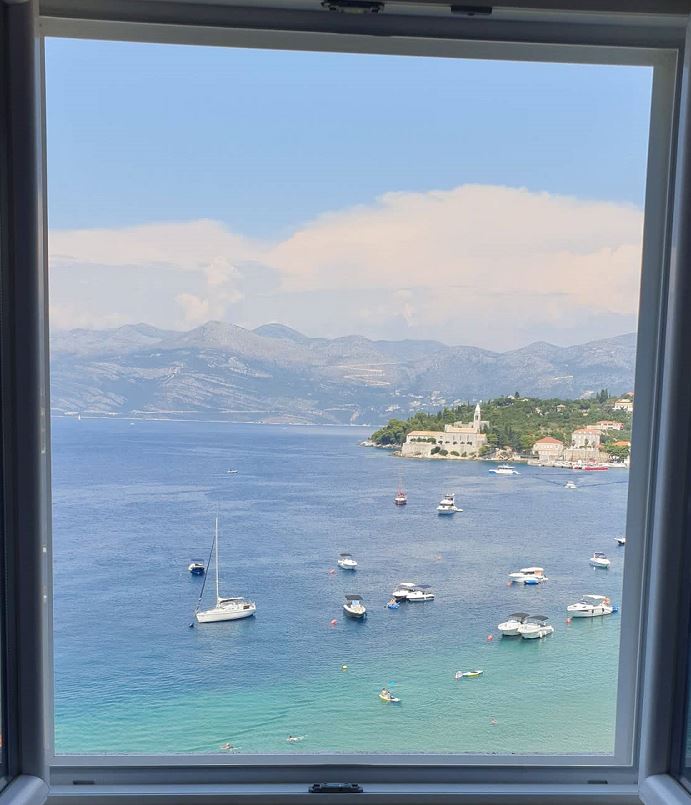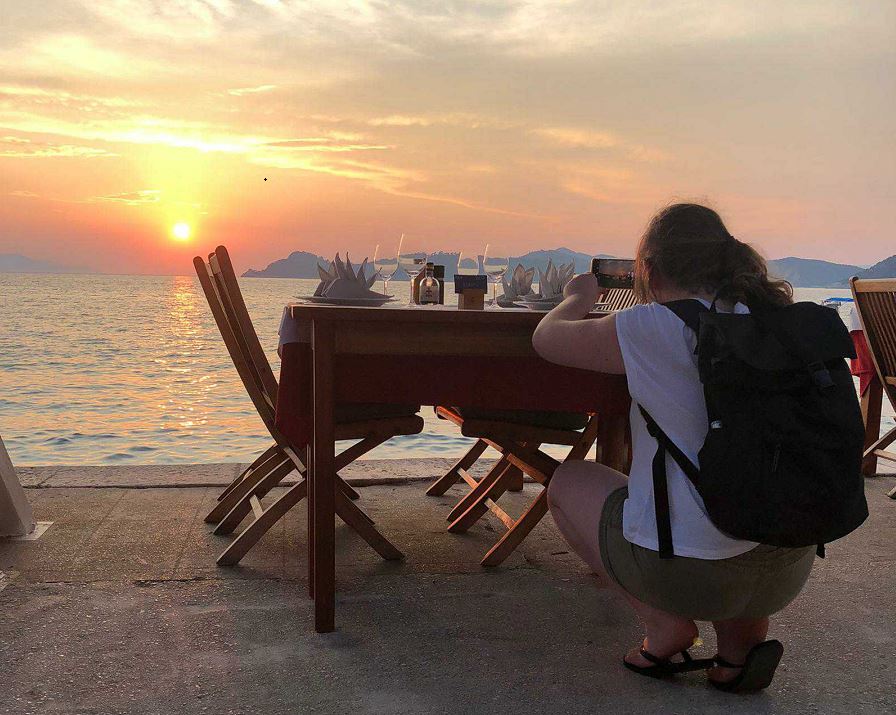Dora Catamaran to Connect Dubrovnik with Elaphite Islands Next Week
July the 21st, 2022 - The Dora catamaran is set to connect the City of Dubrovnik and the mainland with the nearby Elaphite islands (Lopud, Sipan and Kolocep/Kalamota) as of next week as the connections between the Pearl of the Adriatic and the islands continues to improve.
As Morski writes, as of next week the Elaphite islands which lie just north of the city and Dubrovnik will be connected by the Dora catamaran, as was recently confirmed to local portal DuList by the Croatian ferry company Jadrolinija.
''At the request of the local population for the use of fast vessels on passenger lines of transport, and with the consent of the Agency for Coastal Liner Maritime Transport, a temporary approval was obtained to put the Dora catamaran on the aforementioned line. Travellers and islanders alike can expect Dora to start performing this task as of next week,'' stated the official answer signed by Jadrolinija Rijeka, as reported by Dulist.
There has otherwise been no answer to the question as to whether the old Premuda vessel which traditionally maintained this line will go in for overhaul and when that will happen. In addition, a question was asked about another ferry, Postira, and whether or not this vessel is still undergoing overhaul, and if so, why did it take so long to start the process and why is it taking so long so complete it.
Better connections between the Dubrovnik region's mainland and the nearby islands...
Furthermore, in the answer from Jadrolinija, they explained that connecting Dubrovnik with the Elaphite islands is being maintained via two state ferry lines.
''One is a ferry and is intended for the daily transport of both passengers and cargo. The second line is a passenger line maintained by the Postira ferry. Given that the pier on the island of Kolocep was reconstructed last year, the ferry line was redefined, which until now didn't have the possibility to dock at the island of Kolocep, so the cargo had to be transported by our passenger line.
With the reconstruction of the pier on Kolocep, the conditions have been created for all of the islands to be connected with a ferry line, so the sailing times of the aforementioned line will be changed in such a way that it will be able to dock at all ports on both departure and return trips in accordance with the requirements of the local community. The aforementioned change will greatly enable a better connection between the mainland and the islands,'' they pointed out from Jadrolinija.
For more, make sure to check out our dedicated travel section.
Beyond the Dubrovnik Walls: 2. The Island of Lopud
June 16, 2022 - Dubrovnik is perceived to be a 2-day destination with everything concentrated inside the UNESCO old town, but it is so much more than that. Find out what, in the second of a new TCN series - Beyond the Dubrovnik Walls. Meet the island of Lopud.
Seeing things with a fresh pair of eyes is always instructive. Almost a year ago, at the conclusion of the Dubrovnik Nomads-in-Residence programme, A Dutch digital nomad gave an initial presentation to the mayor, tourist board, media and public on his group's findings after 4 weeks as guests of the city. Their brief was to look at Dubrovnik through the eyes of digital nomads and to work with Dubrovnik to create an effective strategy for future development. His presentation was simple, concise, in many ways obvious, and made the whole room pause to think.
His first slide showed the first 30 images on Google Images of Dubrovnik, and they all showed the same thing - the stunning UNESCO World Heritage Site that is the old town of Dubrovnik. One nomad commented that prior to coming to the city, he was not even sure if Dubrovnik had anything of interest or substance beyond the walls. The perception that Dubrovnik was a 2-3 day destination is one that changed during his stay of four weeks, and he announced that after almost a month, he was still not ready to go home.
The magic of Dubrovnik for all these nomads was not the gorgeous old town, stunning as it undoubtedly was, but what lay beyond the walls - the rest of living, breathing Dubrovnik and its surrounding area. In some ways, it was an obvious point, but taking the focus away from the old town seems somehow innovative. And having thought about it, the perception of the reality of Dubrovnik as a destination can only change if we show Dubrovnik, the reality, rather than Dubrovnik, the Instagram poster child.
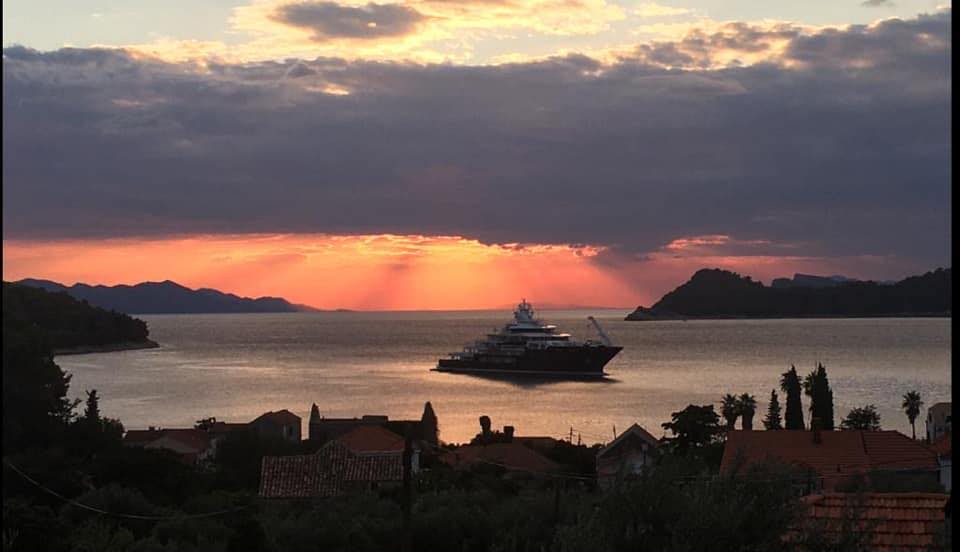
Welcome to Dubrovnik Beyond the Walls, a new TCN series showcasing the magic of this incredible city, but away from its photogenic famous old town. There you can take in centuries of history, culture and tradition, but if you take a bus, boat, or short walk, there are many other Dubrovnik experiences to be enjoyed which complement the famous main attraction. After our first feature article on the Island of Kolocep, also known locally as Kalamota, it is time to swim a little further to the second car-free of the Elaphite Islands, gorgeous Lopud.
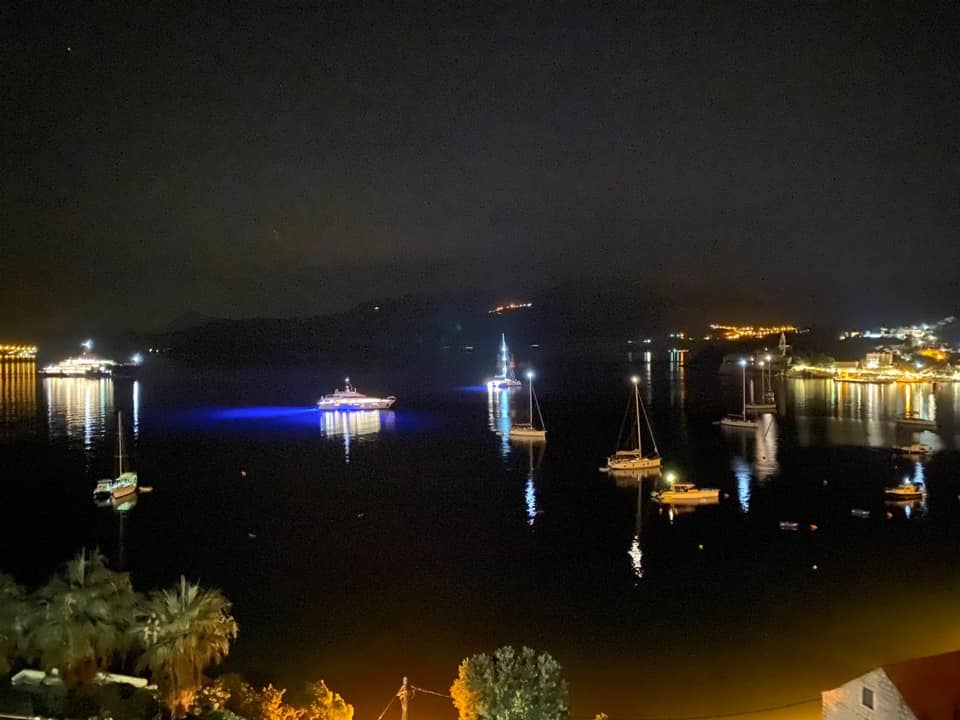
One of the few constants in my Facebook feed during the summer is an almost daily dose of the magical sunsets of Lopud. A friend of mine has roots on the island, and it seems he never tires of the beauty of what he sees before him every evening. I felt that I knew the island's views long before he invited me to visit a couple of summers ago.
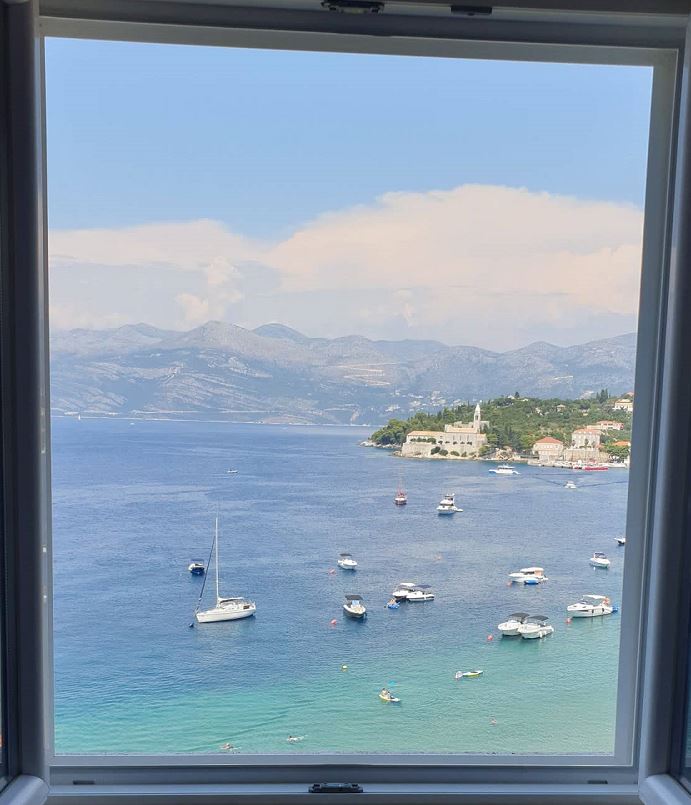
And it did not take me long to fall in love with yet another exceptional Dalmatian island, or to discover that the sunset views were just part of the magic. How about this for a bedroom room with a view, for example? No wonder he was spending less time in Zagreb...
There is an excellent and regular ferry service from Gruz harbour in Dubrovnik, which takes passengers to all three of the Elaphiti islands, stopping firstly on Kolocep, before arriving in Lopud just under an hour after departure. While most of the life on the island is concentrated in the village and riva close to the ferry, sun worshippers in search of a sandy beach make the journey and then hike to the other side of the island for a rare treasure - a high-quality sandy Dalmatian beach.
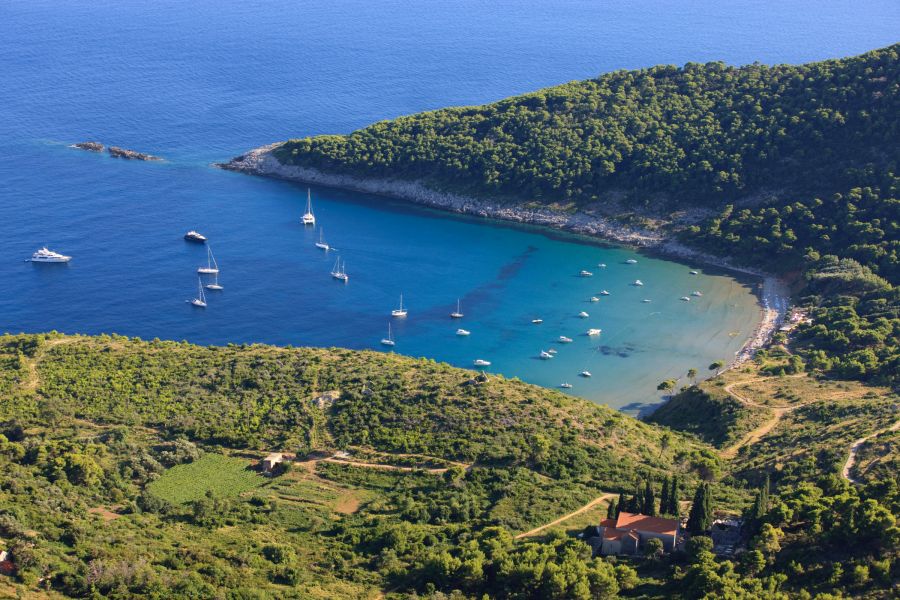
There are quite a few popular beaches in the Dubrovnik area. Some are popular with locals, some with tourists, but none is universally as loved as Sunj Beach. Sunj is located on the south-eastern end of the Island, facing Dubrovnik. Notably, it is Elaphiti’s most popular port of call for private and chartered boats. You can get to it on foot from Lopud village by following one of the marked footpaths through the woods. It bears the name of Czech writer and politician Viktor Dyk who was in love with Lopud. The path also features a monument built in his honour in 1936. Sunj Beach has some beach amenities available like a bar, restaurant and lounge chairs. It is indeed the most spacious sandy beach of Elaphiti and it will remain everybody’s favourite for quite some time.
For the buzz of daily life, however, simply step off the ferry and into the relaxed bustle of traditional Dalmatian island life, where the pace of life is slow and chilled. The riva appeared to me almost like a living room, with some residents actually bringing out chairs in front of the house to soak up daily life.
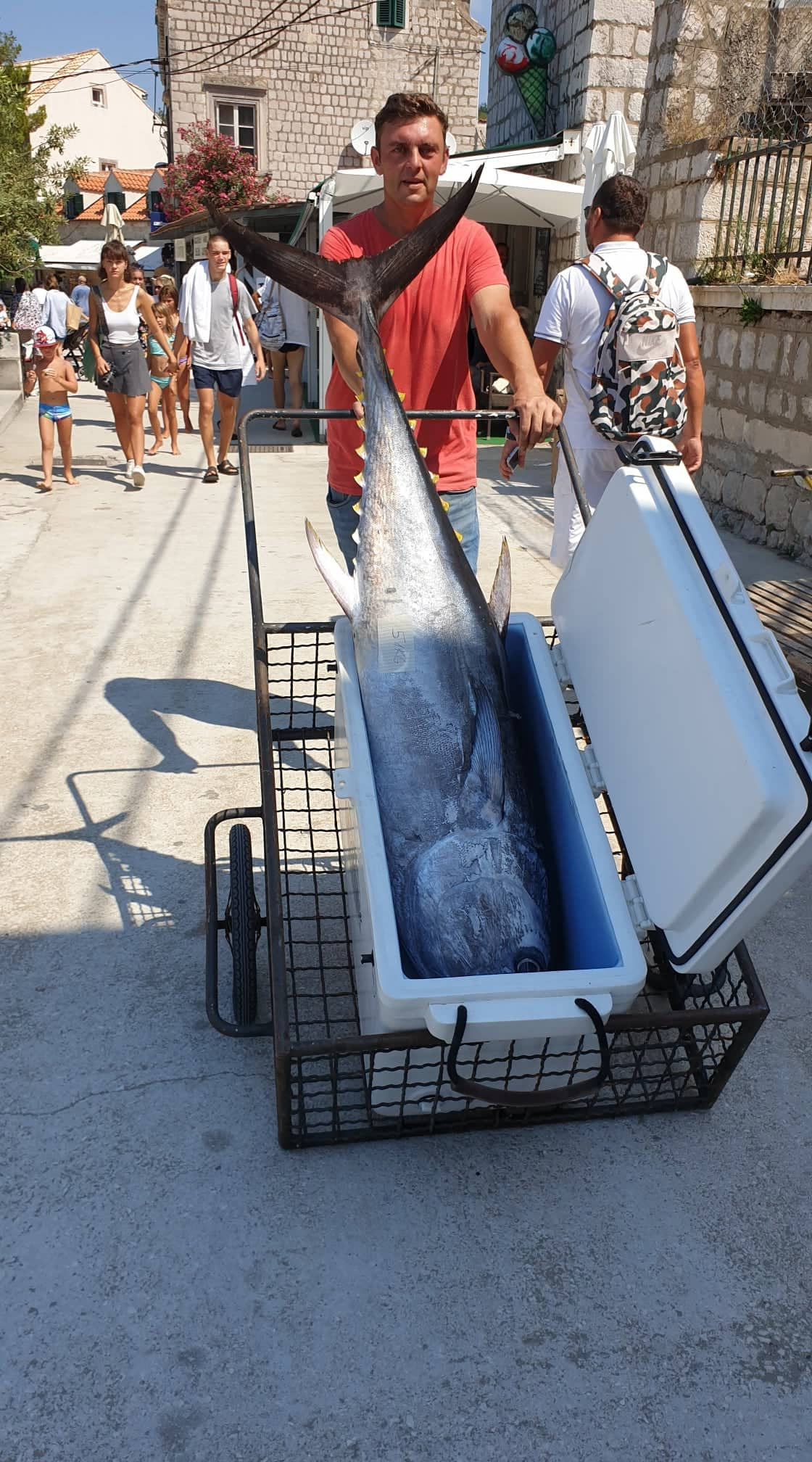
It did not take long on Lopud to work up an appetite. If you are into your seafood, just grab a coffee at a cafe on the riva and watch the catch of the day pass by.
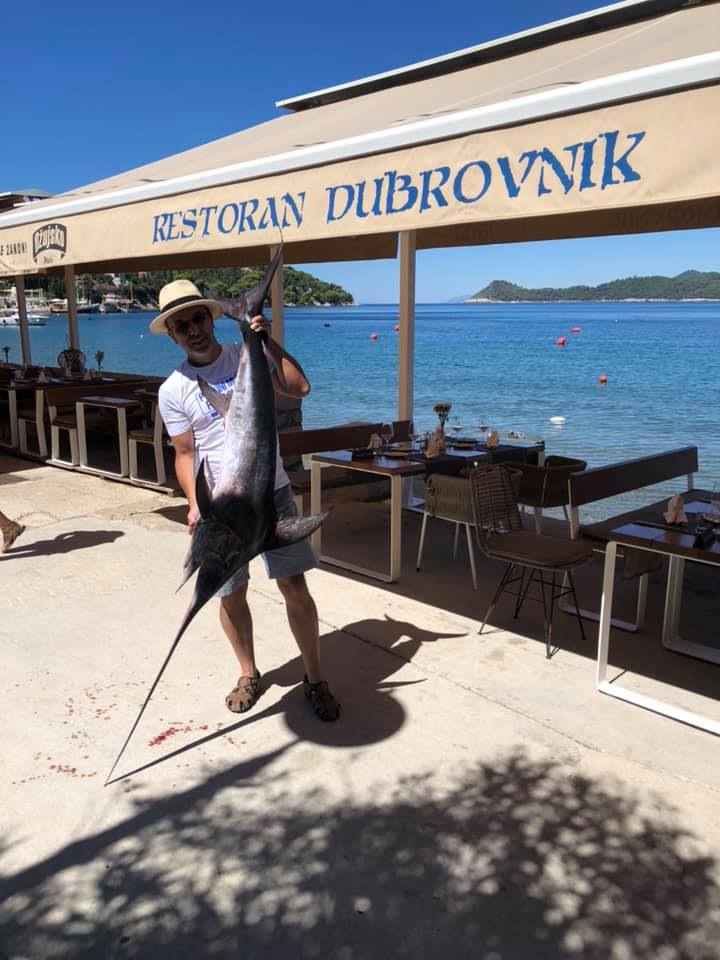
Or check with the local restaurants what they have on offer for the catch of the day. There was something about the riva on Lopud that really appealed to me - something for everyone, including a family-friendly beach, local honey and fig selling their wares, full-time locals greeting Zagreb-based 'part-time islanders' with island banter. Relaxed, jovial, welcoming, safe.
But Lopud also has some rather remarkable and unique treasures to boast, some of them really rather unusual.
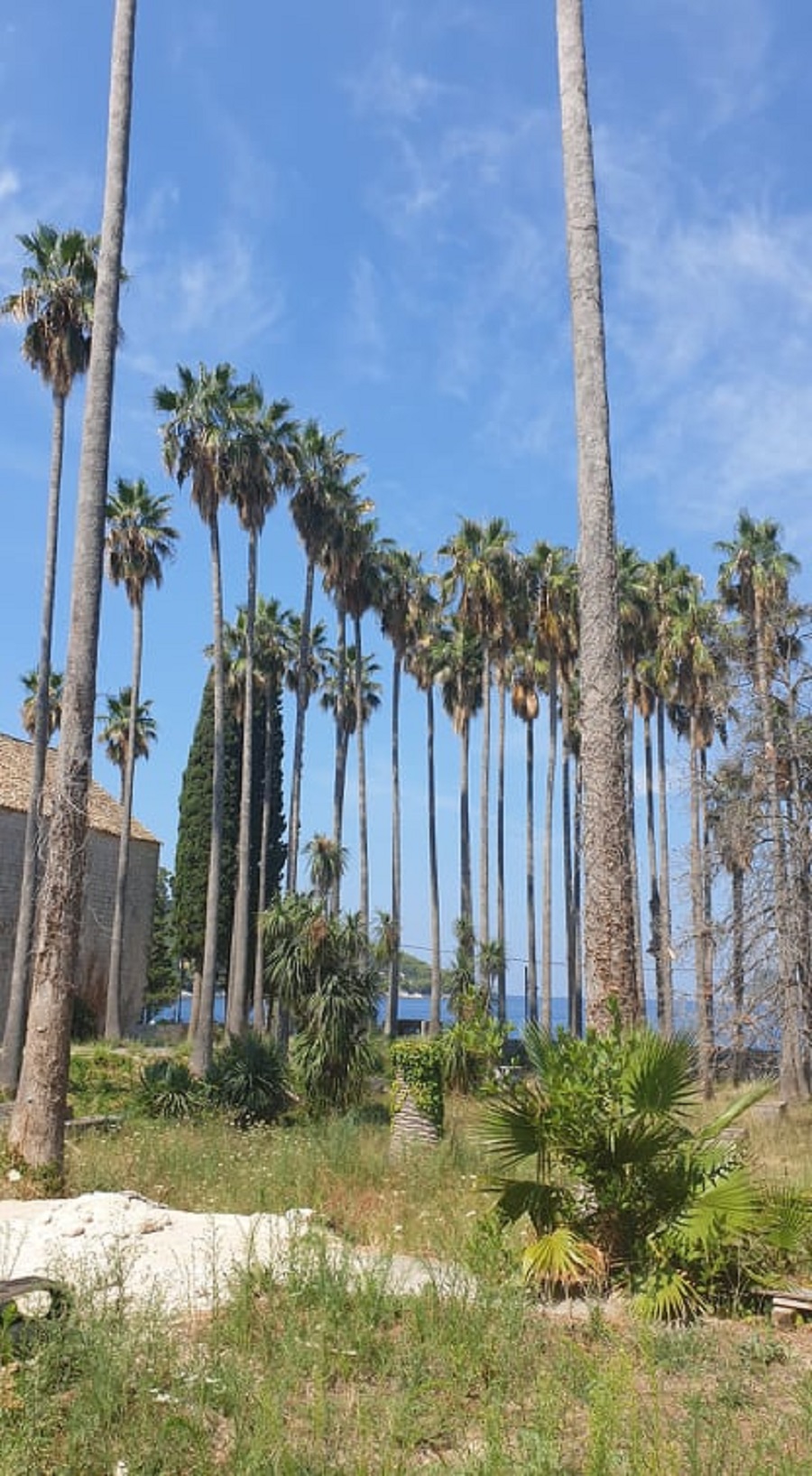
Did you know, for example, that the island of Lopud is home to the tallest palm trees in Europe?
And behind these majestic palm trees, which adorn the Lopud waterfront, is something really quite unusual and unexpected - the world's first concrete hotel, built back in 1936!
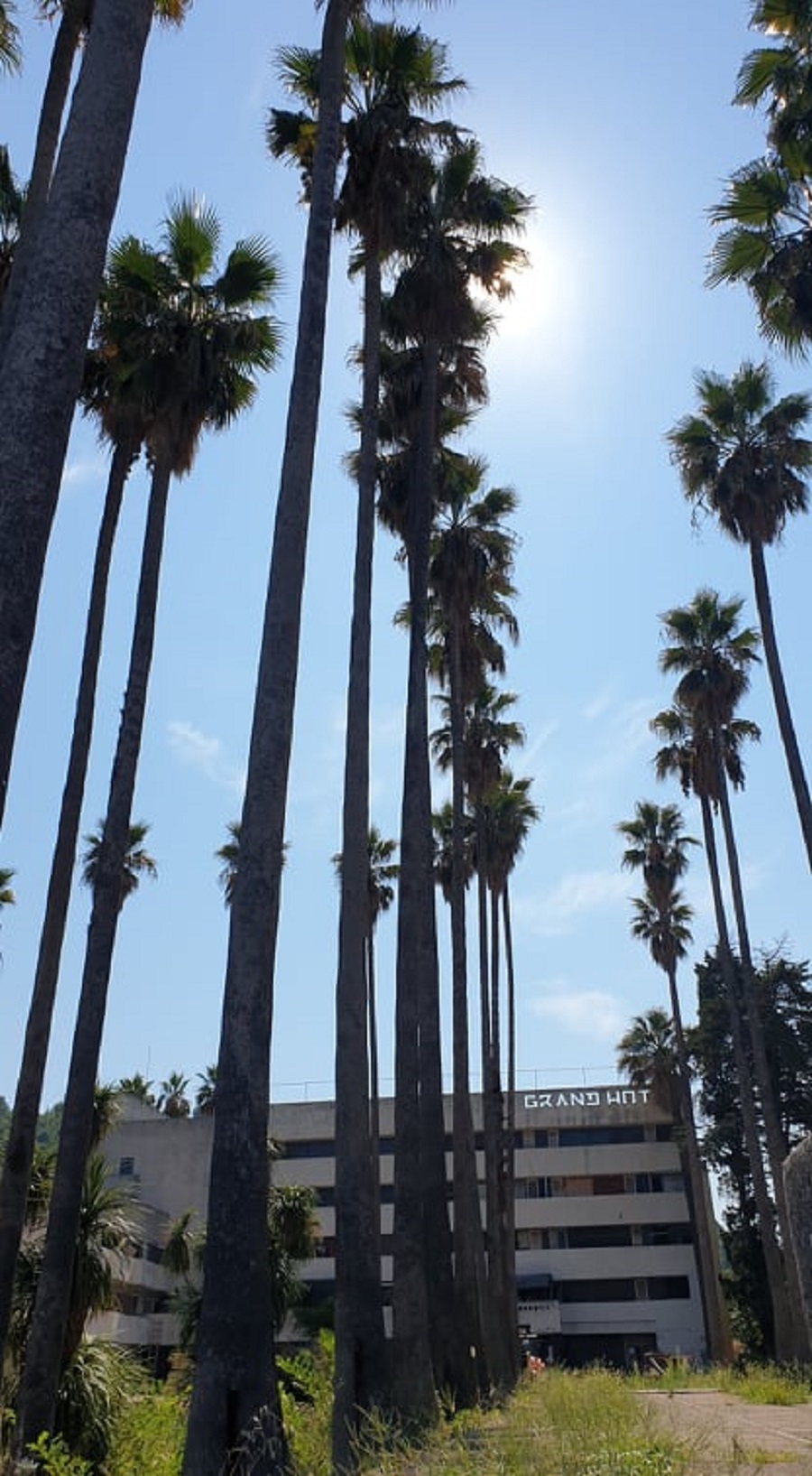
The hotel was opened by Czech owners just 3 years before the opening of the Second World War and is a major example of the bold architecture of Nikola Dobrovic, whose reinforced concrete hotel was his crowning work. It was designed in the shape of a ship from above, complete with a tennis court on the roof, and it looked out to the Adriatic through those impressively tall palm trees, as well as ubiquitous bitter orange trees, for which Dubrovnik is famous.
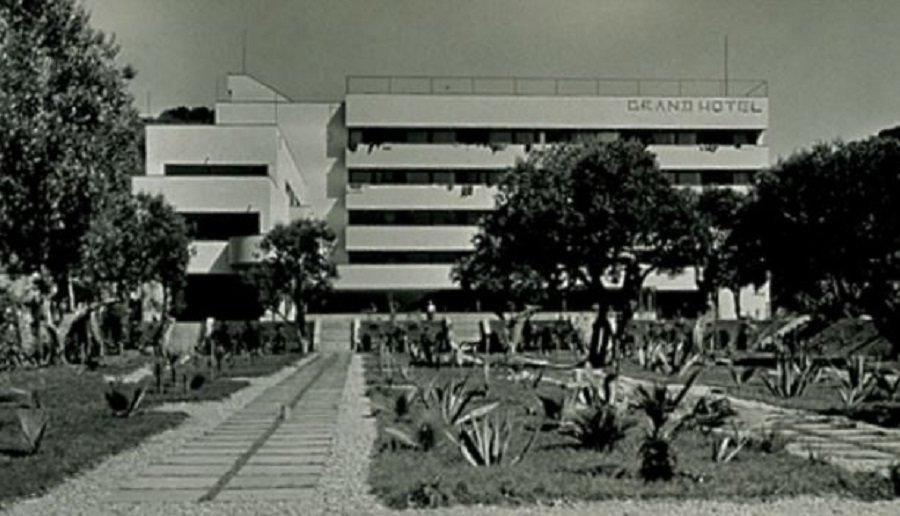
Then came the Second World War, an end to tourism temporarily and a new use for the young concrete hotel - an internment camp for the Jews of the Dubrovnik region. Some 600-700 were interned there. The glory days of this unique concrete hotel were undoubtedly the 1980s before the Homeland War. Life in former Yugoslavia was cheap, life was very liberal, and tourists came to visit knowing they would have a wonderful sun-soaked relaxing vacation at an affordable price.

Plans are in place to renovate the famous concrete hotel, reducing the number of original rooms to provide more spacious accommodation for modern needs. And while we wait, those tall palm trees will continue to sway gently in the evening breeze, as they observe yet one more of some of the best sunsets in Europe.

And while Lopud might have set the pace in 1936 in the world of concrete hotels, today it is leading the way with luxury boutique hotel tourism. Located on the northern peninsula, LOPUD 1483 is a restored Franciscan monastery that has been overlooking the Elaphiti Islands and Croatia’s Dalmatian coast for centuries. After an extensive and sympathetic restoration by renowned art visionary, Francesca Thyssen-Bornemisza, LOPUD 1483 has opened its doors to guests and this five-suite, 15th-century monastery is available to rent exclusively for private stays and events. It is one of THE places to stay on the Adriatic.

For those on more of a budget, there are two more hotel options, both in Lopud village. They are both close to the sea but are vastly different in their design and feel. Hotel Glavovic is a 3-star property and is a recently revived historical hotel originally opened in 1927. On the other hand, 4-star Lafodia Sea Resort is quite a different story. It is a big, modern, and stylishly designed property featuring plenty of amenities and amazing sea views. The island of Lopud also has an excellent range of luxury private villas, many of them with pools.
The majority of Lopud Island’s dining spots are in Lopud Village with some dining options also on Sunj Beach. You will find great choices in the historical Lopud with restaurants Dubrovnik and Obala worthy of a special mention. Hotel Lafodia is also a place where you can find great cuisine. Their La Baja Bar & Grill is a cool option for enjoying a bite to eat or a refreshing drink next to the beach. This restaurant is known for featuring live entertainment in the evenings as well. Many of Lopud restaurants have terraces with amazing views over the bay and will not let you forget what a gorgeous place you are spending your vacation.
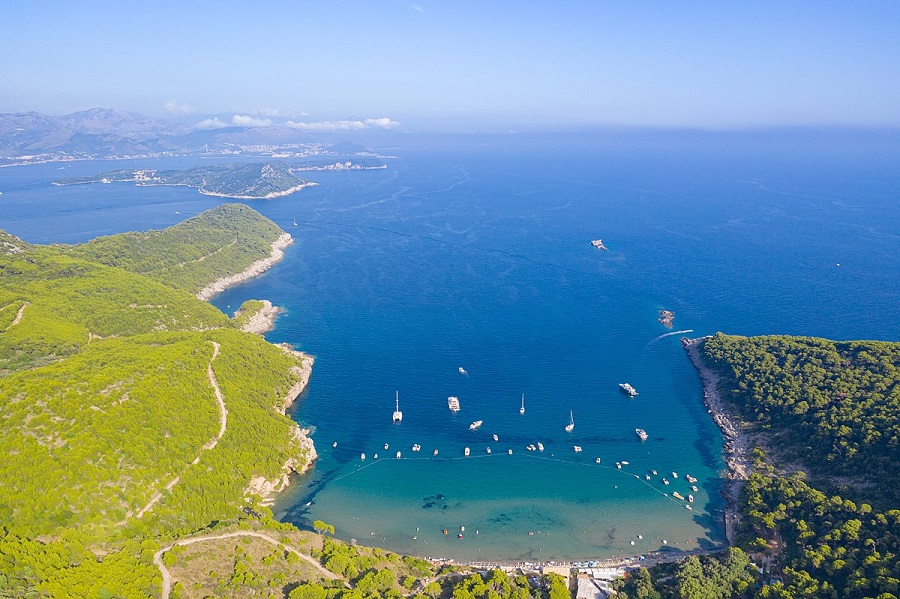
A quite magnificent island, and one which is less than an hour by regular ferry from Dubrovnik. The pace of life on the island of Lopud could not be more different from historic Dubrovnik.
Dubrovnik beyond the walls, a new way to look at the Pearl of the Adriatic. And with so many different options available, tailor your Dubrovnik experience to your specific needs.
To learn more about the Beyond the Dubrovnik Walls series, follow the dedicated section.
Croatian Beauty & 35.5m Lopud Transmitter Beast: Seriously?
January 26, 2022 - One of Croatia's most gorgeous islands, a film set for Bliss starring Own Wilson and Salma Hayek, and the 35.5m Lopud transmitter that is enraging local residents, tourists, and foreign investors.
Bliss. I can't think of a better word to explain my state of mind when I visit the island of Lopud, a short ferry ride away from Dubrovnik.
The 2021 sci-fi movie of the same name, starring Owen Wilson and Salma Hayek, showcases this unique slice of Dalmatian island heaven to the world, and you can learn more from my first visit in Lopud: Carless, Timeless, Carefree Dalmatian Sunset Heaven.
But a change in the Lopud skyline is causing considerable local anger, the renovation, and expansion of a transmitter tower from its current size of 13 metres to a whopping 35.5 m.
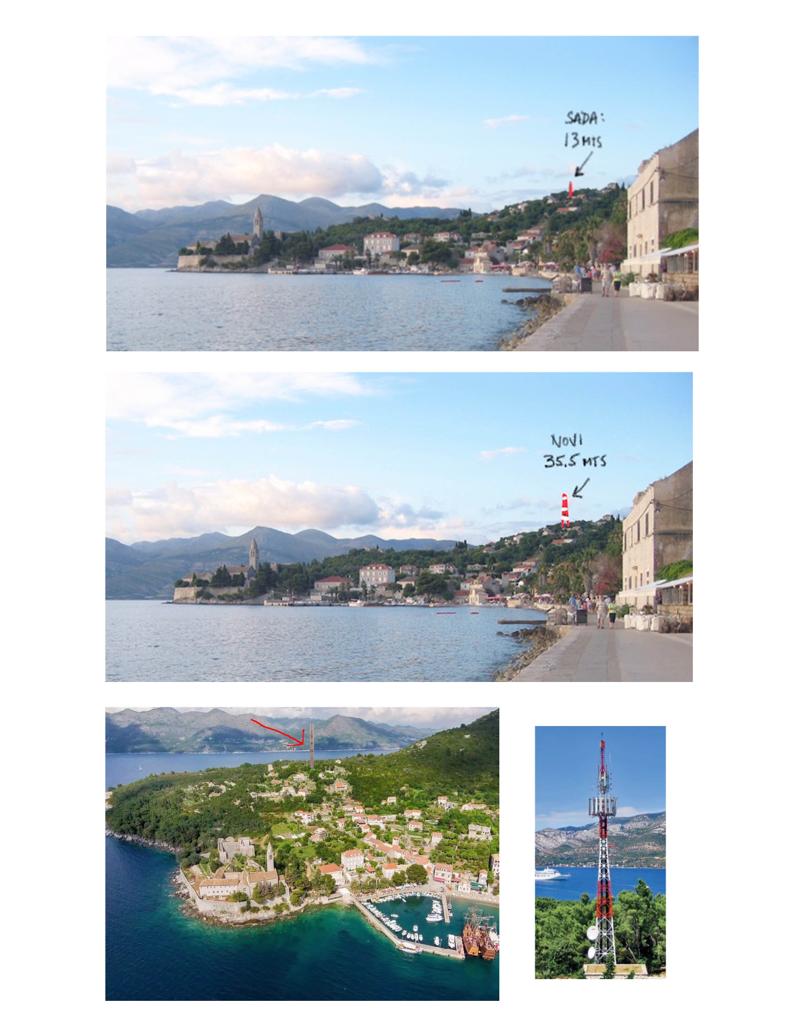
While it may look like a prop from the Bliss film set, the tower is real - and perfectly legal.
The existing complex is being renovated and many people assumed that this would mean a renovated tower at the same height. And when construction began a few months ago, the local backlash was swift and vocal, including from globally-recognised names who have invested on Lopud.
Baroness Francesca von Thyssen-Bornemisza, formerly Francesca von Habsburg-Lothringen, is an art collector and owner of the renovated monastery, which has become one of Croatia's leading boutique hotels.
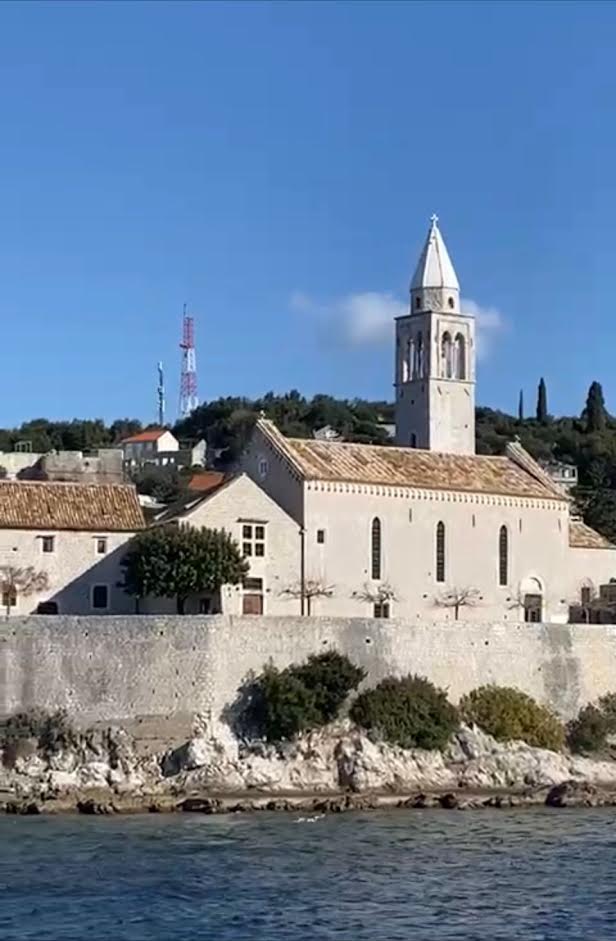
"This is exactly the kind of thing that gives Croatia a bad name. Over the years I have seen foreign investors come and go, because of the chronic application of double standards on multiple levels. The whole group of us have not only transformed the Northside of Lopud over the last decades, but have also actively contributed to the revitalization of the island in numerous ways, and we continue to do so. All restoration of monuments and buildings have been executed according to the strictest standards imposed by the Institute of conservation, and we feel profoundly betrayed by them allowing a monstrosity of this size to be built in such close vicinity of so many heritage buildings. It's not possible to forbid adaptations to these properties that are in keeping with modern living, and tourism requirements, with great attention to aesthetics, on the basis that it's "not in keeping" with the historical fabric of a place when this obscenity is allowed to overshadow all the authenticity that we have all fought so hard to preserve.

"I am sure that Mr. Bače, the newly appointed Head of the conservation institute is intimately familiar with the urban regulation rules of the City of Dubrovnik, which is also valid for Lopud, that no antenna and similar infrastructure should be built in the vicinity of the listed cultural monuments and protected natural areas, so how he allowed this to happen is seriously problematic. In this regard, Toto Bergamo Rossi and I are in touch with UNESCO where we both have very good relations because of our good standing in the cultural field, and we are taking this dispute up to the highest authorities, otherwise, nothing will ever improve here. For my part, this is the drop that makes the vase overflow."

A press release from the residents of Lopud has more:
Residents of Lopud are asking investors, the Odašiljači i veze company, to suspend work on the construction of a 35.5 meter high new transmitter, which is planned to be located in the immediate vicinity of the most densely populated part of the island and legally protected monumental heritage.
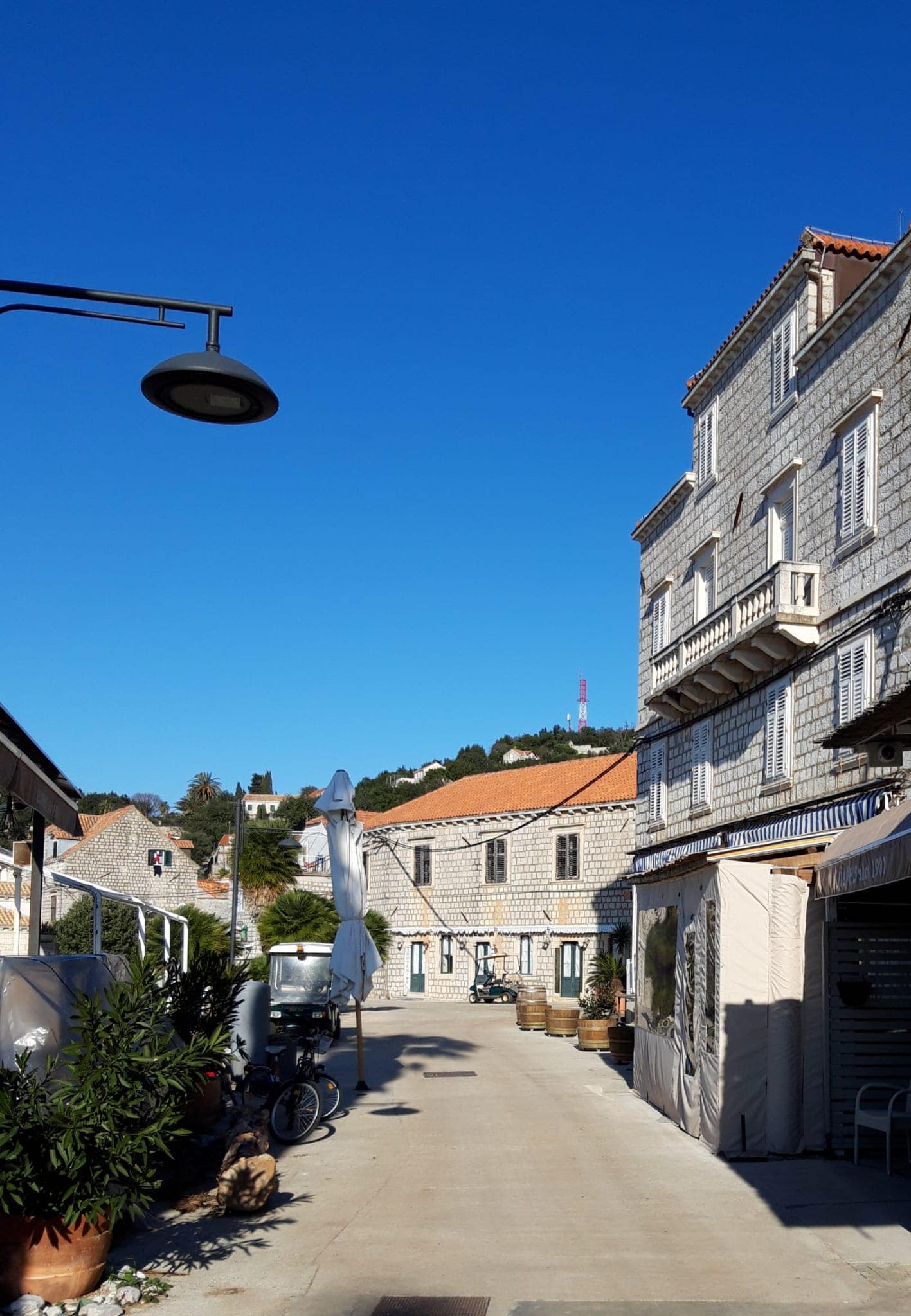
Residents of Lopud are unpleasantly surprised by the plans that inside residential area, which until recently was uninhabited and neglected, and now abounds with renovated houses and holiday villas, as well as protected historical buildings and cultural monuments that are under special protection of the Republic of Croatia, and are an attractive backdrop for film and television hits, a new transmitter is being built, which, due to its monumentality, will completely disturb the view of that part of Lopud.
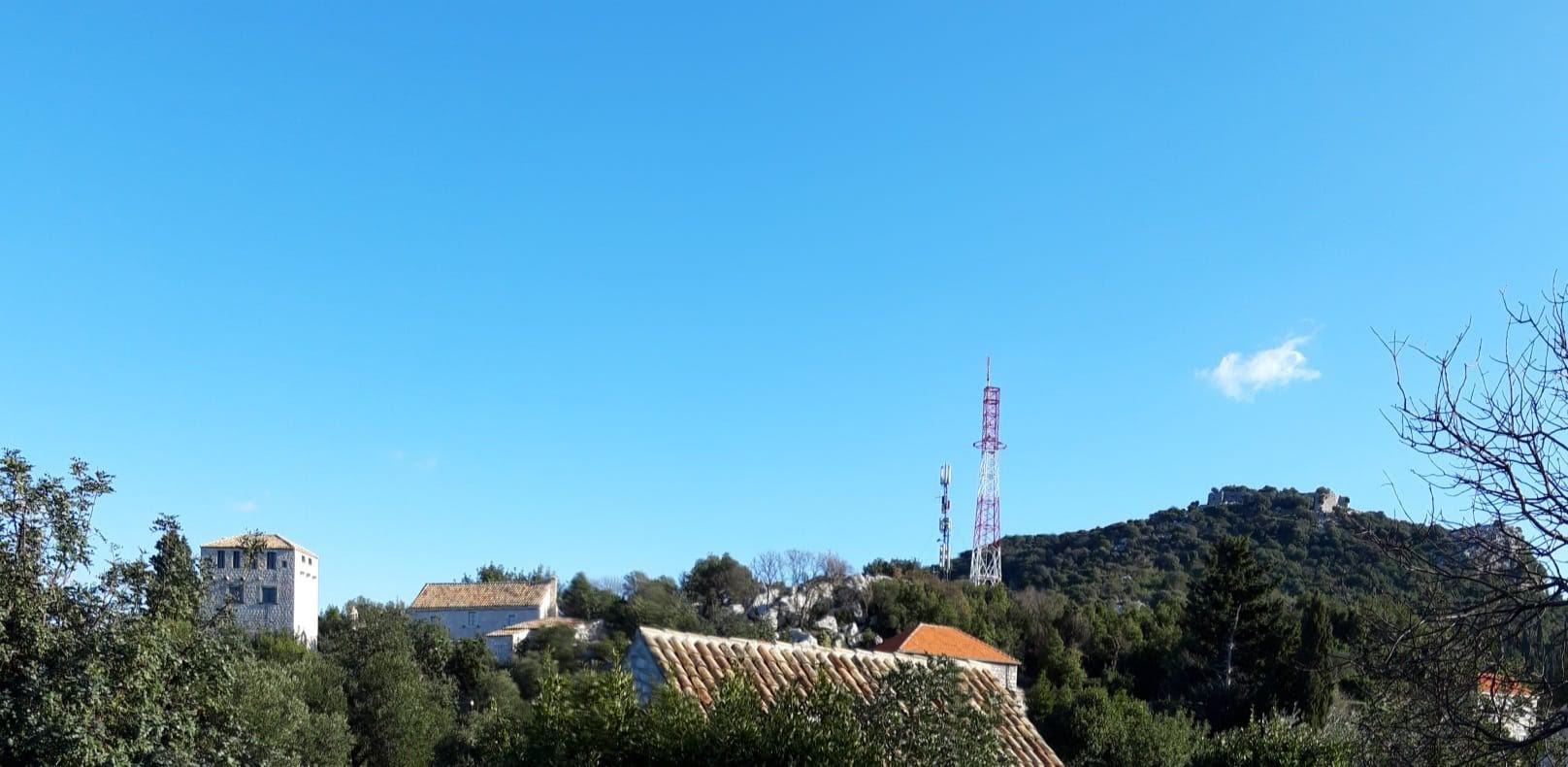
Residents of Lopud initially thought that the started work was related to the reconstruction of the existing transmitter, but it soon became clear that instead of a simple renovation, an even three times larger facility is being built.
"Particularly problematic, we estimate, is the fact that the new tower will be 35.5 m high, and even 2.73 times larger than the existing transmitter that needs to be replaced. Given its size, it is to be expected that additional antenna system equipment will come to it, so it is logical to conclude that this will lead to more electromagnetic radiation, about which no one has informed us so far," said Ivo Mihajlovic, a resident of Lopud.

Residents of Lopud are therefore asking the investor, the Odašiljači i veze company, the provider of national strategic communication infrastructure for transmitting and transmitting signals, to suspend work on the existing location until another suitable solution is found, ie to move the tower outside the residential area where it will have less impact on the health of residents and will not permanently disturb not only the view of zero category monuments, but also the tourist valorization of facilities located in the area.
An online petition has also been set up (you can sign it here)
As residents, visitors and admirers of Lopud, its unique harmony of nature and living historical sites, we would like to hereby express our opposition to the replacement of the existing 13 m antenna in Lopud with a new antenna of 35.5 m.Such a drastically greater change directly next to the inhabited, oldest urban part of the place (moreover, outside the prescribed construction zone!) imposes a strong industrial impression on the whole village which is contrary to the touristic idea of Lopud and its image as a natural and historically and culturally significant destination. As one of the most visited day trip areas for guests of the city of Dubrovnik, Lopud is important for the overall image of the city and how it wants to present itself as a tourist destination.The health impact of such a powerful antenna on us islanders, within the edge of the settlement, is also questionable. 90% of the island's inhabitants live exclusively from tourism, so it is of the utmost importance for all of us to preserve and further develop the right image of Lopud and to be transparently informed and involved in such invasive and other, positive projects that may affect the quality of the island.
Appeals to the Mayor of Dubrovnik, Mato Frankovic, to intervene, have been heeded, with Mayor Frankovic writing to the company, requesting them to stop.

More on this story as we get it, with no further comment from our side required.
To learn more about the incredible and (so far) unspoiled Elaphite islands of Lopud, Kolocep and Sipan, check out the dedicated Total Croatia guide.
Summer in Croatia Through the Lens of Croatian Photographer Timotej Gošev
November 20, 2021 - ''I want people to look at my photographs, and simply desire to be right there in the place their eyes are seeing'', says Timotej Gošev, better known as Timotej on Instagram, inviting thousands of people every day to experience the Adriatic summer through his photographs. Total Croatia News managed to interview the photographer with Varaždin roots.
In what ways can photography positively impact the promotion of tourism in Croatia? The question may sound simple to answer, but nowadays photography can be manipulated in such a way that the first impression of a tourist upon arriving at his destination is one of disappointment. It happens in many parts of the world. The use of visual content, to be used responsibly and strategically, can be essential to make Croatia known around the world.
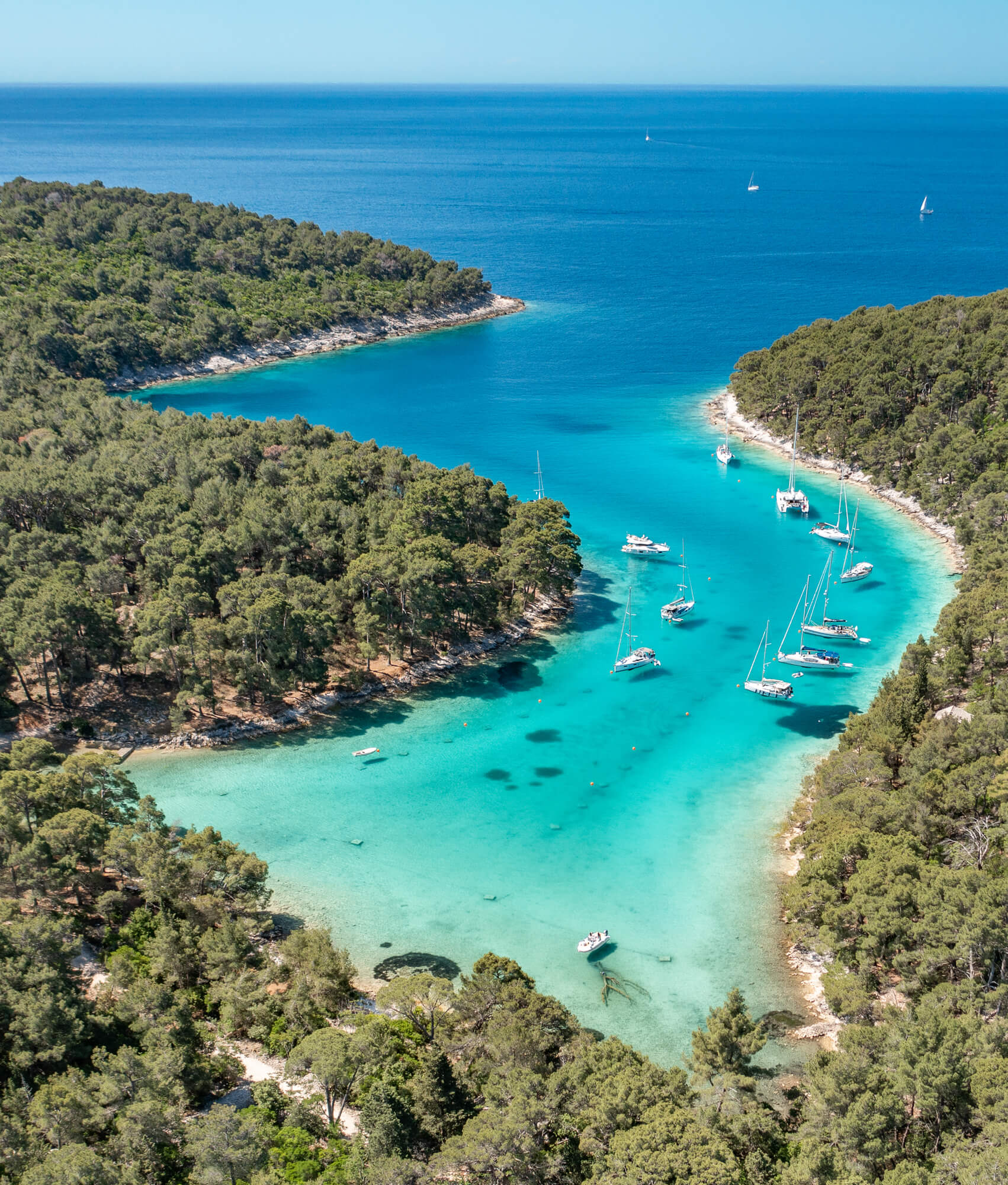
Krivica Cove and beach, Lošinj (Photo: Timotej Gošev)
Now I live in Croatia, but for 24 years of my life, my only reference was what I saw on the internet and on social networks. Now that I have spent two summers here, I can attest that Croatia has the advantage of meeting the expectations of those who came with a preconceived image in their heads. Those turquoise and transparent waters that you see in photos and videos, they are like that! But the Adriatic coast of Croatia is very extensive, and to it, we must add its more than 700 islands. Imagine the number of remote and wonderful places along almost 6000 kilometers of coastline that must exist to fulfill your fantasy of an Adriatic summer. Well, a Croatian photographer is dedicated to exploring, capturing, and sharing the magic of these places with his thousands of followers.
If you have looked for photos of Croatia to corroborate what everyone is surely saying about it, chances are that you have come across Timotej's photos. Also, if you have seen one of his photos, it is most likely that you have already bought your air ticket to spend the following summer in the Adriatic.
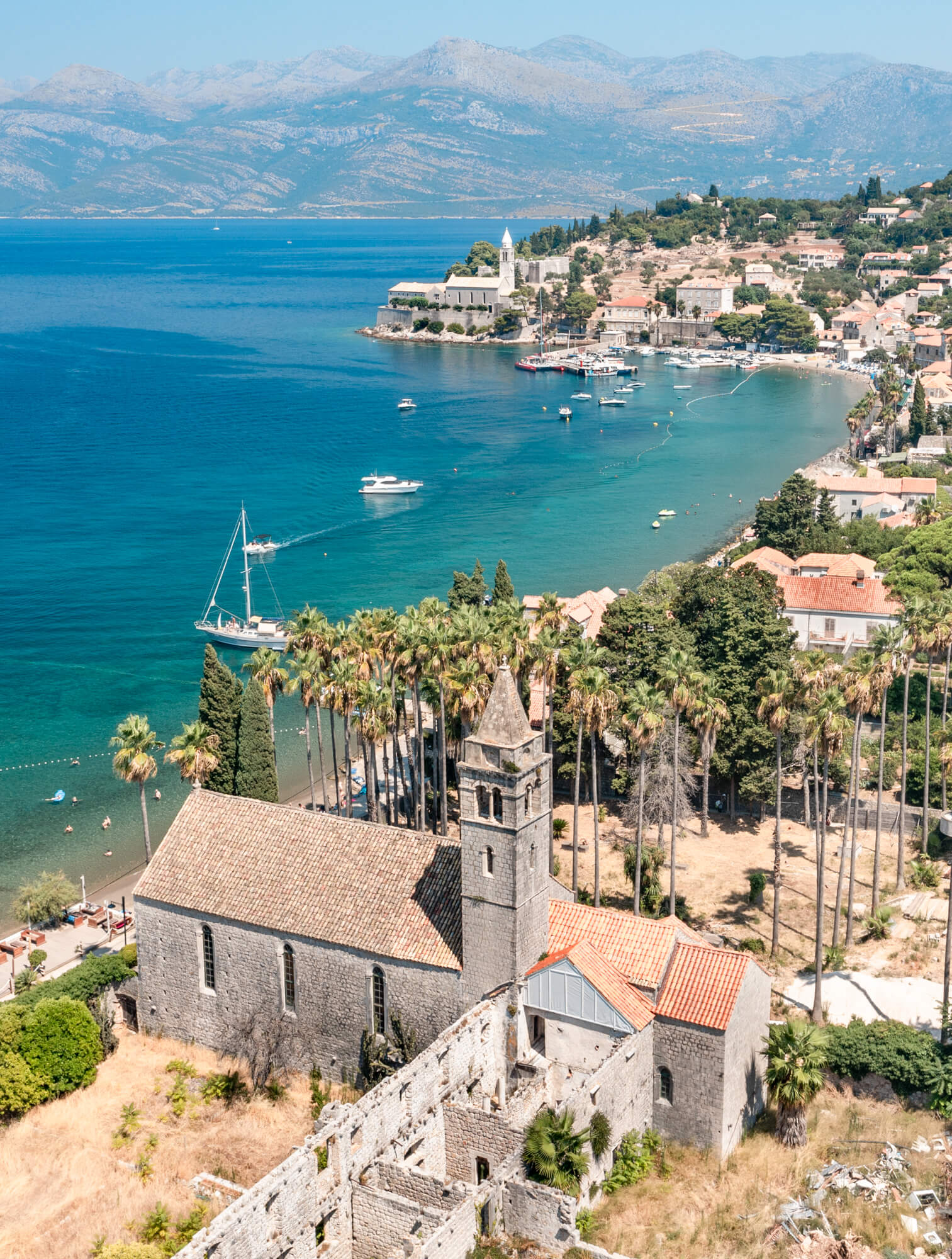
Lopud Island (Photo: Timotej Gošev)
Croatia will always stand out for its history, and its stories. But being someone who has lived most of his life on another continent, I am aware of the visual impact that Croatia has on other countries in the world. Especially in these times, many friends shared with me photos or videos that they found on Instagram, Facebook, Pinterest, TikTok, or Twitter, and they could not believe that such a place existed, and especially in Europe. When it comes to paradise islands and turquoise waters, many think of Hawaii, the Caribbean, or the islands of Melanesia. But Croatia has already positioned itself as an alternative Eden, and one that combines dream destinations and a calendar packed with cultural activities.
I find it impressive that a photo is able to motivate someone to book airfare and accommodation. I think this reinforces the idea that the world is there to be explored, and that Croatia is one of those must-see destinations in it. But for this to work as it has been working in recent years, it is necessary that all the tourism promotion forces in the country aim towards the same objective. There is the National Tourism Board, the local Tourism Boards, and why not, talented Croatian citizens who use their platforms and content to highlight their country in a showcase.
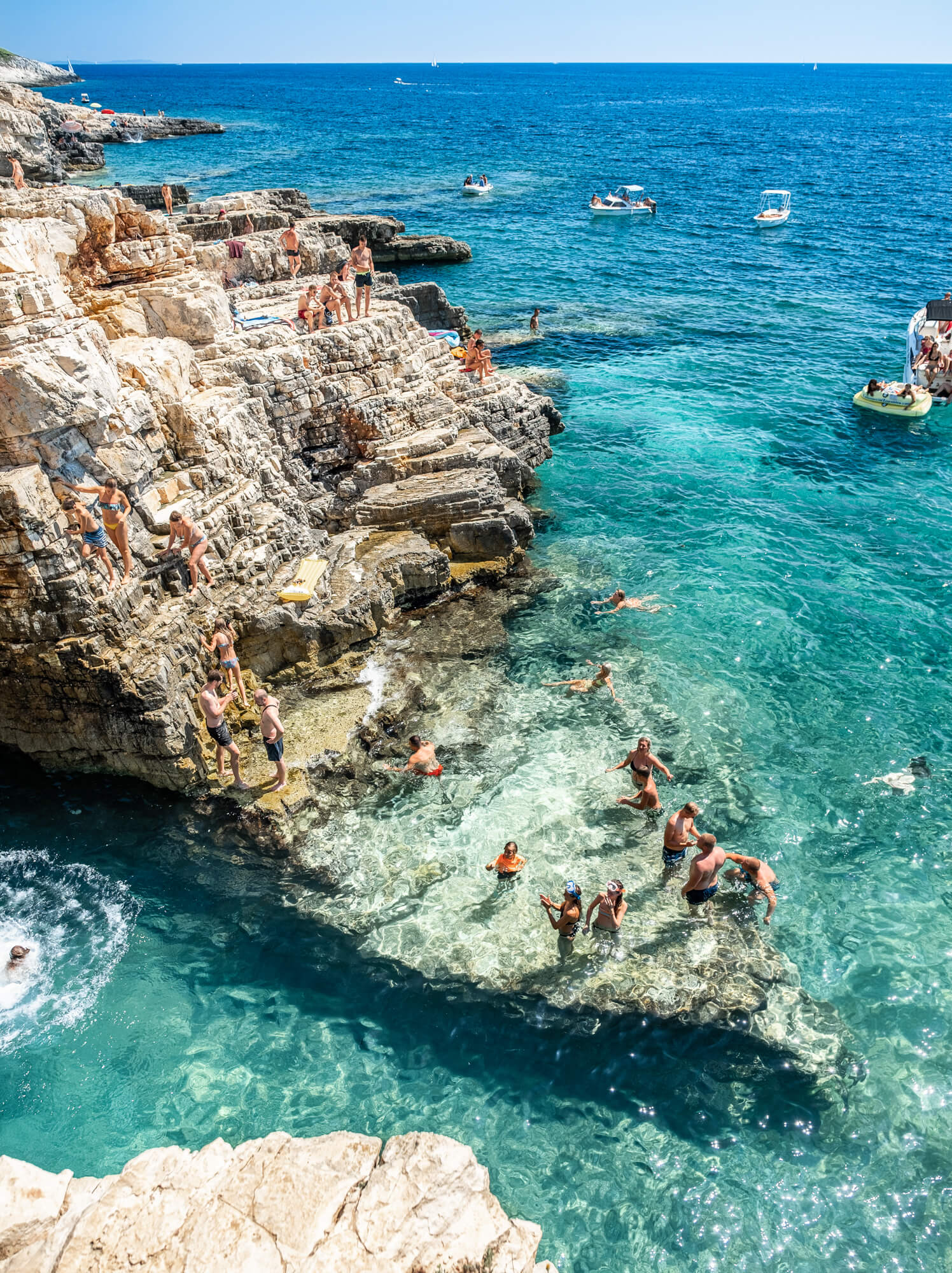
Kamenjak, Istria (Photo: Timotej Gošev)
One such person is precisely the famous Croatian photographer Timotej Gošev, who's approaching his mid-thirties, and currently living in Berkshire, England. He's the owner of the @timotej Instagram account which has become one of the largest social media accounts in the world by sharing travel photography and recommendations from only around Croatia. With almost 100 thousand followers on Instagram, his pictures often go viral and are reposted and shared by some of the biggest media groups such as Forbes, Conde Nast, as well as the biggest re-sharing travel accounts on Instagram such as Earthpix, Travel & Leisure, Wonderful Places & Beautiful Destinations. If you haven't seen his photography yet, be sure to check his Instagram first. He also has an impressive guide to his top 30 favorite beaches in Croatia, you can check it here.
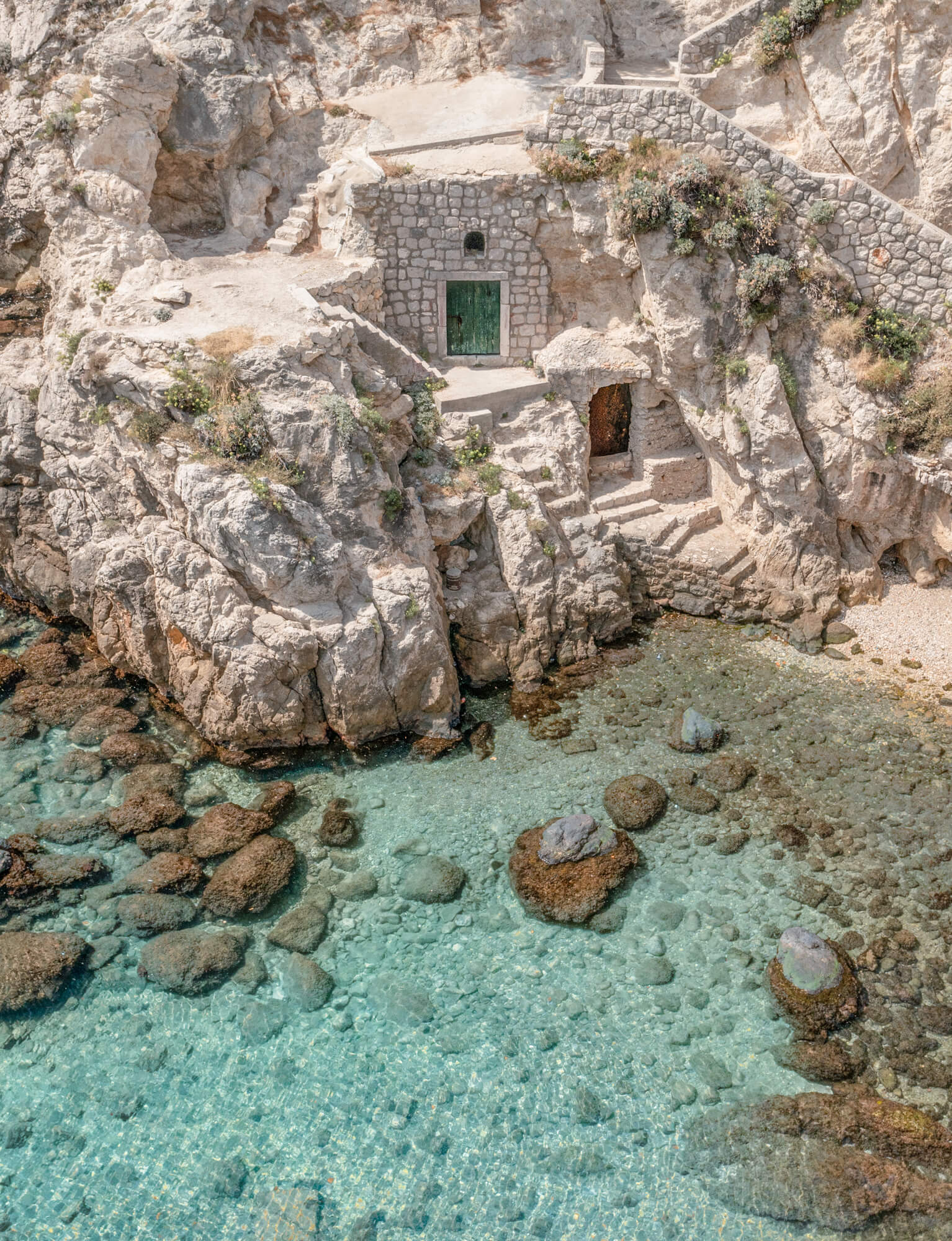
Dubrovnik (Photo: Timotej Gošev)
Timotej shares with Total Croatia News about his special connection to his country, his photography, tourism in Croatia, his future projects, and much more.
The vast majority of your followers and all of those who have come across your photographs on social media already know you for the quality of your work and your captivating images. But few know about your personal side and your history with Croatia. How does this connection with Croatia begin? Were you born and raised in Croatia?
It’s true. A lot of people see my photographs on Instagram, and just by looking at them can say this looks like one of Timotej’s photographs. However, very few people know me personally. Remember, I am a photographer sharing photos from around Croatia, through social media, to the world. I am not another influencer showcasing my life and hoping to influence you to be like me. My goal is to inspire people through my photography to visit and fall in love with Croatia.
It’s also very amusing to me, how so many people are surprised that I’m from Croatia. Even Croatians often assume I’m from somewhere else. I was introduced to Nina Badrić for example, and she knew of my photography but thought I was a Slovenian photographer. I think it’s purely because my name, Timotej (pronounced ‘Timo-tey’ in English), is not so common in Croatia. Think about it, most boys in Croatia are named after the first four books of the New Testament Bible. Ivan (John), Marko (Mark), Luka (Luke), Matej (Matthew). My mum wanted to be a little bit more original with her Biblical name choice, so she looked further down the list until she came to Timotej (Timothy). Simple and straightforward explanation.
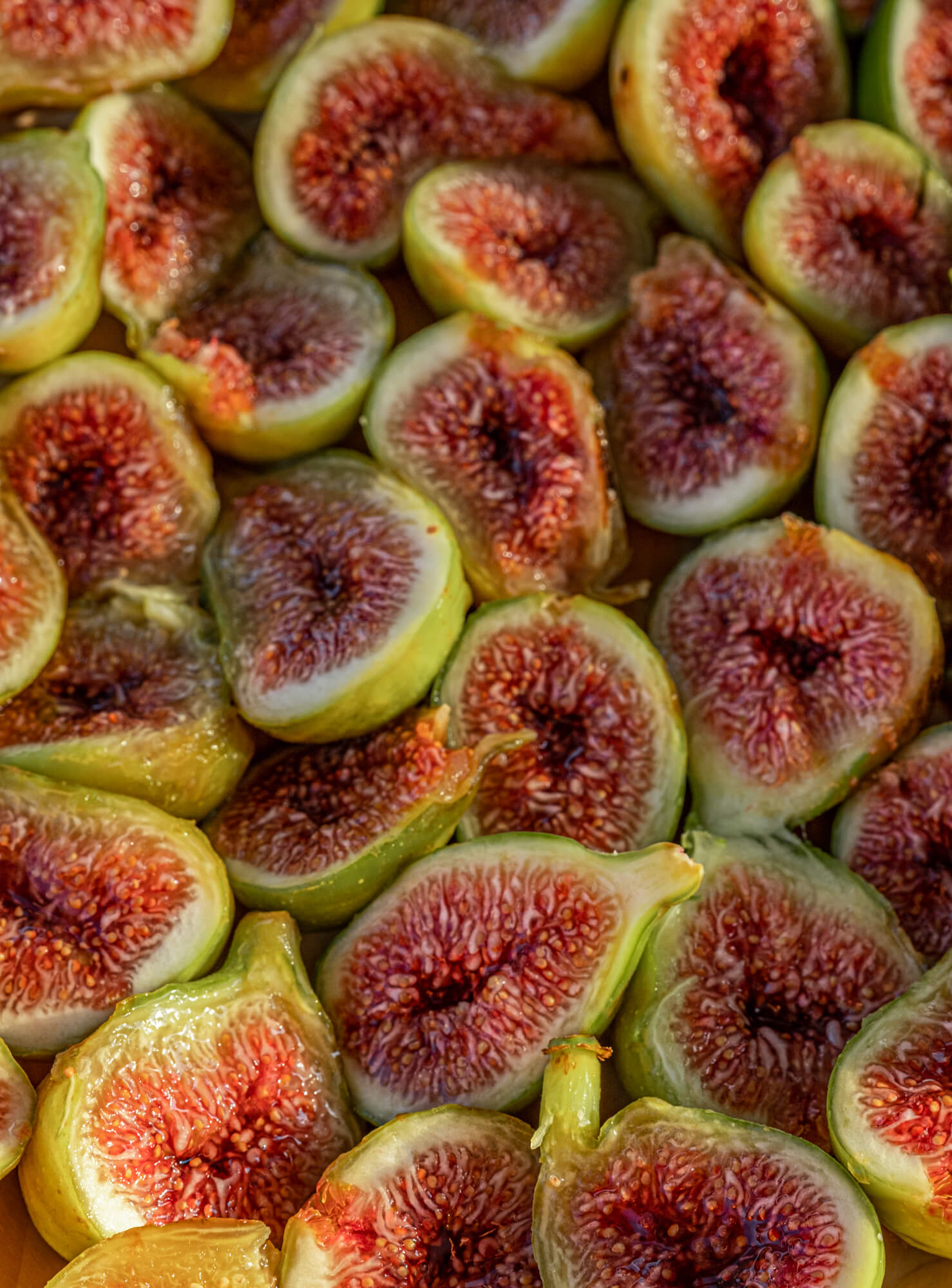
Croatian figs (Photo: Timotej Gošev)
My parents came to study in England after finishing their high school and army service in Varazdin, so I was born in the UK. But a few years later we moved back, so my younger brother was born in Varaždin. After a few years, my parents realized they could make a better life for our family back in England. So, once again, we moved back. Thankfully Croatia is just a drive and short flight away from England, so I was lucky enough to visit very often growing up. I can speak, read, and write Croatian too. I believe an Instagram account like mine, can only really belong to a Croatian, in love with his country.
Nowadays, when one associates the words ''travel photography'' and ''Croatia'', one of the first things that come to mind for a lot of people is ''Timotej''. How did you get started in photography and how has the learning process been so far? Is there another type of photography that you like equally?
I’ve been into photography for as long as I can remember. Cameras and lenses, all the gear, simply fascinates me. So does the quest to snap a perfect picture. As a child, I always wanted to press the camera’s shutter button and shoot everything. This wasn’t possible, as it was still the time of film cameras, and film roll was precious, so parents couldn’t let me waste it taking fifty pictures of nothing. So you can imagine my joy when digital cameras came into existence with memory cards.
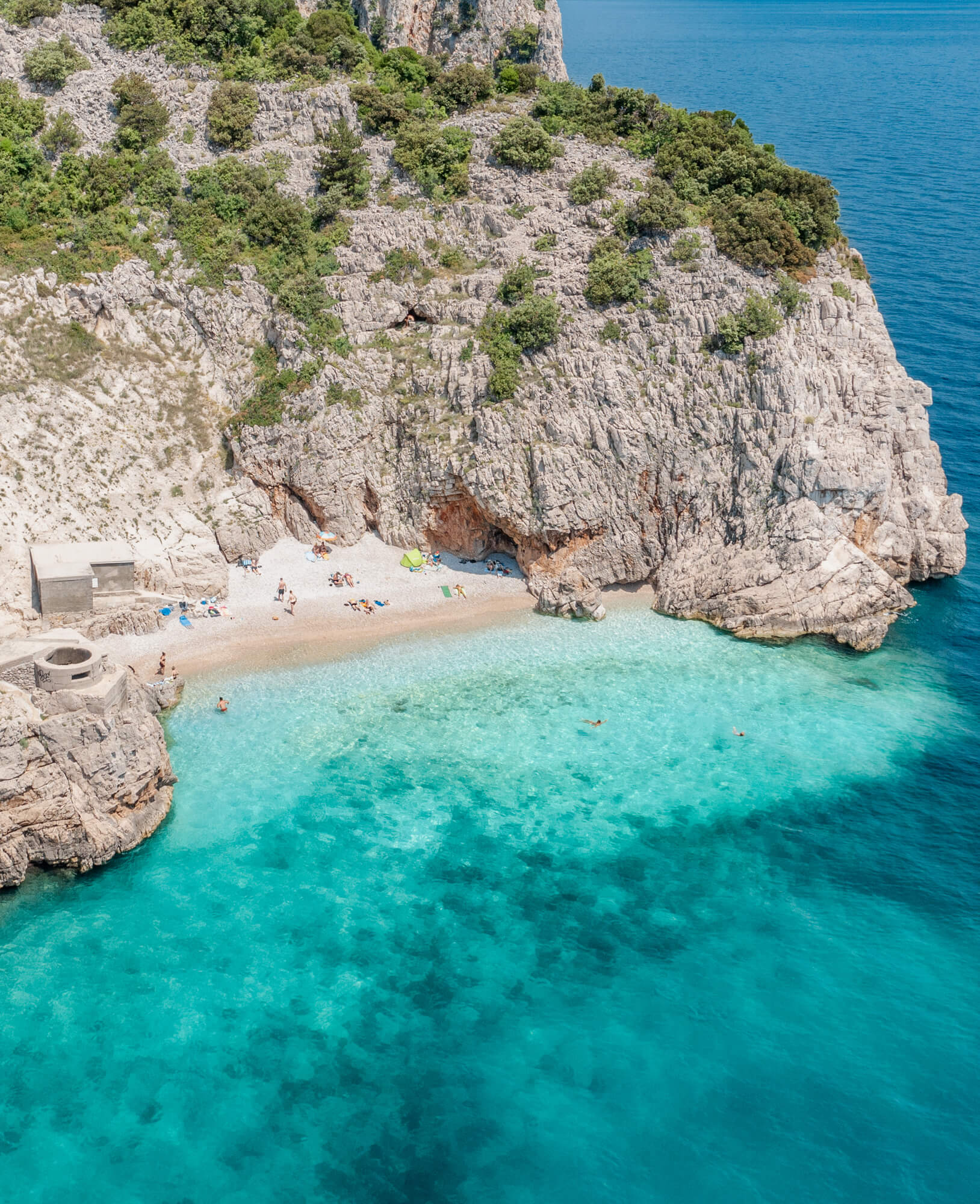
Brseč, Primorsko-Goranska (Photo: Timotej Gošev)
As far as learning goes, when you figure out how to work a camera/lens, the shooting settings, and how light affects the scene being shot, everything comes down to one’s eye for a good picture. Personally, for me, the learning these days mostly centers around training my eyes even more. If you take 50 shots, 1 can easily turn out perfect. But the goal is to be able to take 1 shot and make it perfect first time. Sometimes this means learning to be patient. Waiting. It can also mean making a bigger effort to find a unique vantage point. Doing research to find out what has already been shot where you are shooting.
I love beachscape photography as you all know, and architectural too. I also love to shoot macro shots. I really want to do more wildlife and food photography in the future.

Restaurant Mandrač, Lopud Island (Photo: Timotej Gošev)
What inspires you to be a travel photographer and how has that changed in recent years?
I’m in love with the Croatian coast and the Adriatic Sea. Its beauty simply inspires me to capture it with my cameras. I am lucky and blessed to be able to call such a place, my country. I want to see and explore as many spots along the coast, and visit as many islands as my lifetime allows me too. Each place is its own world. People today are so obsessed with seeing as many countries as possible, but few have had the pleasure of truly knowing, exploring, and enjoying theirs. I love going back to a place I’ve already visited, to see how it’s changing, developing, and evolving. I am constantly inspired by the big and little changes happening everywhere. The way I see it is, that there is a lifetime of exploration for me and capturing moments with my camera. There is no getting bored.
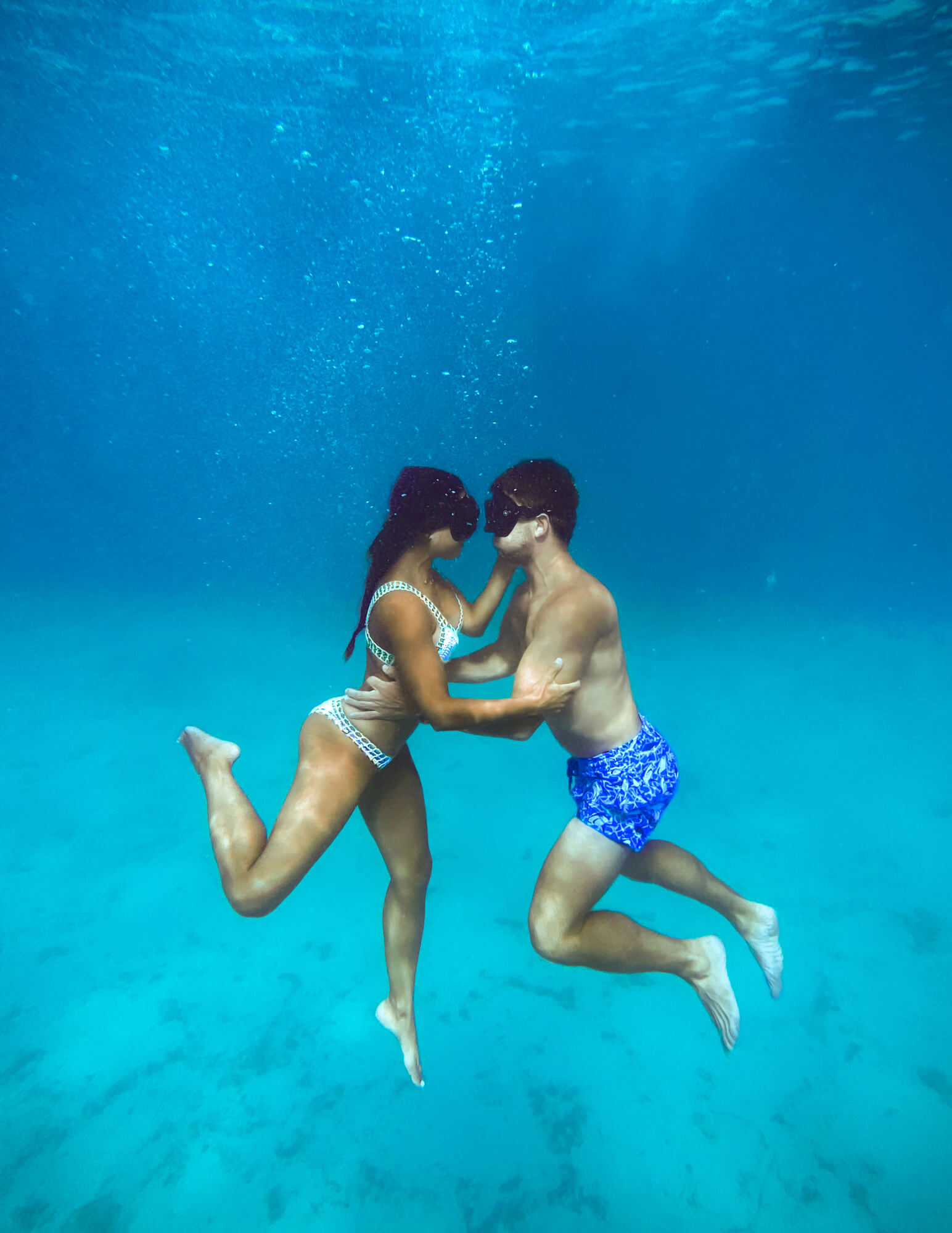
How do you manage to balance your time between the UK and Croatia? Has Brexit affected in any way the way you travel between the two countries?
I like to be in Croatia during the summer, so I can enjoy the sea and beaches. It’s where I experience the most joy. Since I got my driving license, I have been planning my life in a way so I could spend the maximum possible time in Croatia every summer. To my surprise, neither Brexit nor Covid19 has affected my travels to Croatia. I have dual nationality. Croatian and British passports and therefore was legally allowed to travel to go to either home. With negative PCR test results, I drove England to Croatia three times during the pandemic. When you have a registered photography business in the UK, going to Croatia to shoot photos is a legitimate and valid reason to travel for work too.
How would you describe the personal style behind your photography? And how about your visual style?
I want people to look at my photographs, and simply desire to be right there in the place their eyes are seeing. To imagine themselves living the moment being shown. My photos need to mentally seduce and show the essence of an Adriatic summer experience in Croatia. People think my visual style is really unique, but it’s a classic beachscape visual style used in travel magazines and by some of the world’s most known beachscape photographers for decades.

Sveta Nedjelja beach, Hvar (Photo: Timotej Gošev)
It is a beautiful summer day in Croatia, how does Timotej spend it from start to finish?
I like to wake up early. No need for coffee. I really believe in seizing the daytime. I want to be the first on the beach. Put my towel in the best spot, and go for a morning swim to truly wake up. Love soaking in the early morning sun too. Around 9 am, it’s time for a light breakfast, and then back to the beach where I’ll stay until lunchtime being as active as possible. I prefer to stay in apartments, so for lunch, it’s usually time to cook something, rather than eat out. After lunch, it’s back to the sea/beach until sunset. The afternoon is usually about exploration. Then shower, dress up a bit and go to town for dinner and some ice cream. I always end up chilling on apartment terraces late into the night, always in good company getting into deep conversations.
It has happened to me on several occasions that I have decided to put my camera aside so as not to miss the experience. How do you manage to consistently create content and live in the moment at the same time? Do you have any advice for other travel photographers?
It’s actually very simple for me. When I go to a place in Croatia, I am not going there to take a picture. I am going there to enjoy the experience and moment of being in a place which brings me total joy. I live the moments fully with my camera at home, or in my backpack. After I enjoyed the place, explored it, I come back with/take out a camera. Also, I don’t live from making social media content and I don’t have any pressure to create content. My advice to travel photographers is that when you decide to shoot a place, make a decision to spend at least 1 week there. Don’t follow the content creator crowd, and a lot of Croatian photographers, are doing this, in that they go to a spot for a few hours with the purpose of taking a photo and then off to the next location.
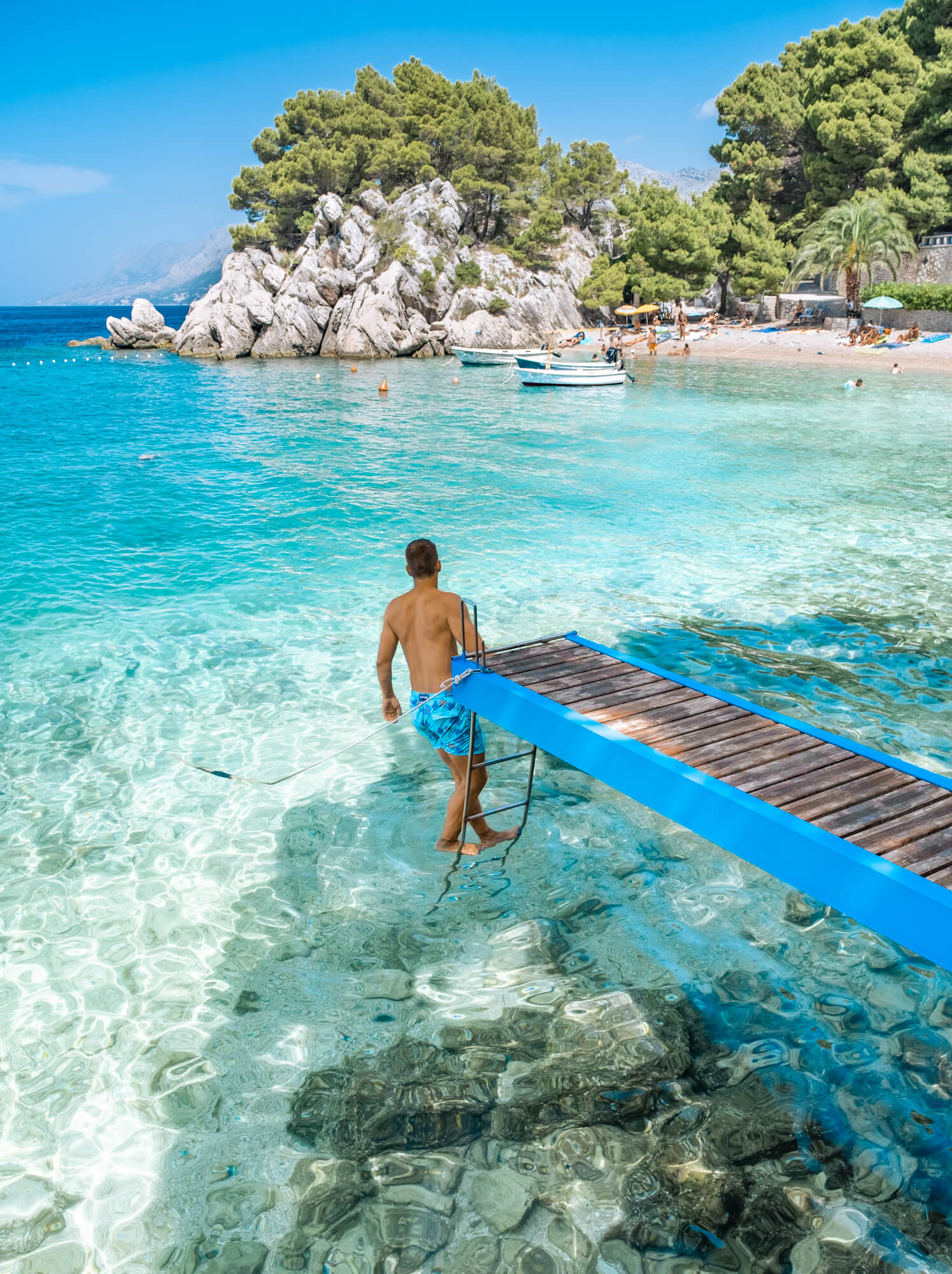
Brela, Dalmatia (Photo: Timotej Gošev)
A photographer was telling me how they photographed every nice spot on Korcula Island in 1 day. Don’t make this same mistake. The world’s most famous beachscape photographers, when shooting a particular area, commit to spending a whole summer season there, chasing the billion-dollar shot, as we say. I can’t commit to a whole summer in one spot yet either, but everyone can do 3-7 days. 1 to enjoy without smartphones and cameras at least.
It could be said that you lean more towards photography of landscapes and places, but would you like to also venture into a type of travel photography where you can also highlight the Croatian people, their traditions, and their customs?
My focus is the Ljeto (Summer) in Croatia. The goal is to photograph and show the summertime experience. Naturally, there is a lot of landscape shots. But if you have been following me for a while you also see the entire summer experience. If I go into town at night and see a cultural dance, or traditional outfits, if I like what I see, I will photograph it. But right now, the priority is to show beaches and nature, accommodation, and things one can experience when visiting Croatia in the summer. I am showing what my audience wants to see.
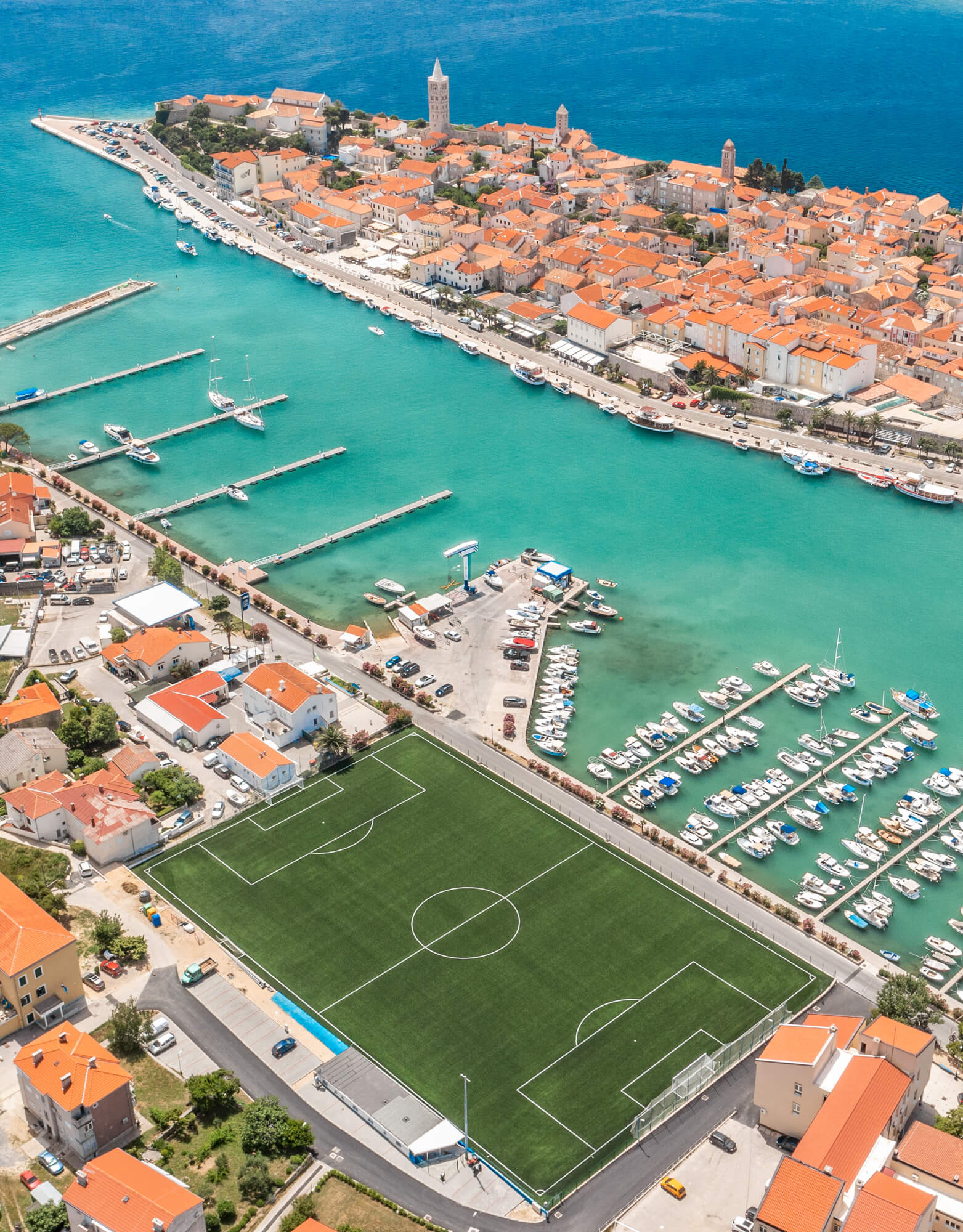
Town of Rab (Photo: Timotej Gošev)
However, if Drago Sopta retires, I would gladly like to venture off and take over as the photographer of the Croatian National Football team and take pictures of the guys playing football. I believe in myself as a photographer, and my ability to shoot in a variety of styles.
It is said that there is an excessive amount of drone images to visually promote Croatia and that they do not accurately reflect the possible experience of a tourist (for example Izvor Cetina or the Croatian islands from above). But you manage to combine both images with a drone as well as those from a personal point of view. How can both promote tourism in Croatia?
Look, Zlatni Rat Beach shot with a drone, from above, looks like one of the most beautiful spots in this world. It’s unreal. Then you come there, stand on the beach, and you can’t really see it from the vantage point the drone did. So you now have two options. The first is to get upset, choose to be negative, and leave disappointed, as many do. Or you can think about it, and say to yourself, I’m standing on this magical beach full of shape-shifting pebbles, surrounded by perfect water, and enjoy the beach all day. Every destination spot in the world that looks good from above is excessively photographed with drones. Those saying it doesn’t accurately reflect the tourist experience are a very small minority, and they are there for the wrong reason in my opinion. I believe you need both to give the true picture to someone. Let them know what it looks like from above and below. Balance is key. I like to show how it looks from ground level and from the sky.
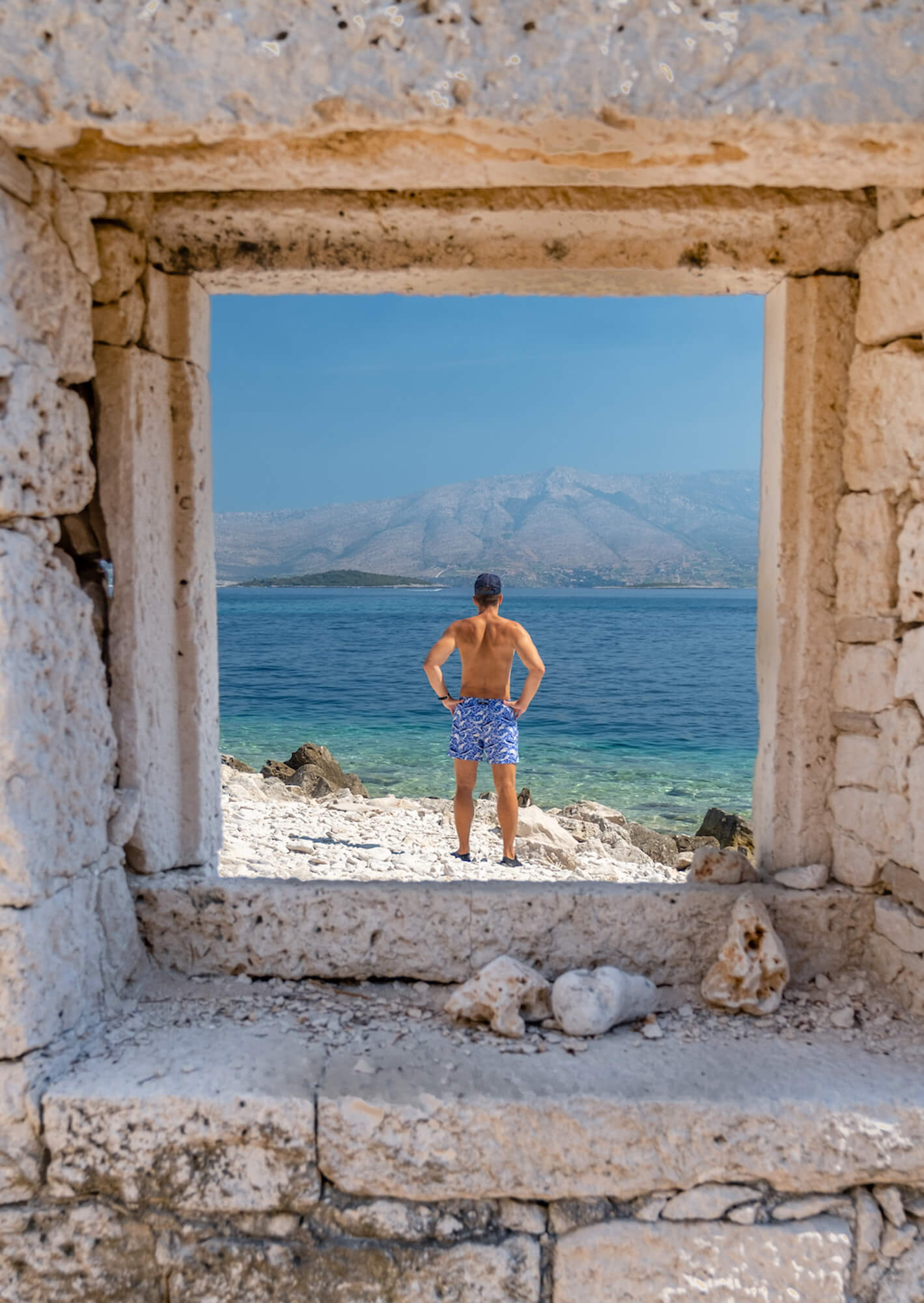
Otok Vrnik (Photo: Timotej Gošev)
Many content creators avoid bringing discussion topics to their feed to avoid losing followers or getting into disputes with them. But in addition to visually promoting Croatia, you also take the time to raise awareness about caring for the environment, such as animal rights and the situation about smoking in Croatia. Is it necessary for content creators to be ambivalent in that regard? What responsibilities should someone with so many followers and a lot of reach assume?
I always speak my mind. From day one on Instagram. I have my opinions, and my account is a space where I can share them as well as my photography. I don’t expect everyone to agree with them and that’s okay. Does Croatia have a smoking problem? Yes. Have tourists noticed it? Yes. Is it destroying our beaches? Yes. A lot of what I highlight are facts and truth. Common sense. It’s already been said by others, and it’s very much connected to keeping Croatia’s land beautiful and not destroying it. I don’t live from Instagram, so if I lost all my followers tomorrow, it does not affect me in any way. As for disputes, occasionally some arise, but surprisingly not a lot. I think the things which I’m highlighting are things the overwhelming majority of my followers agree with me on. We all want to keep Croatia clean and beautiful for generation after generation.
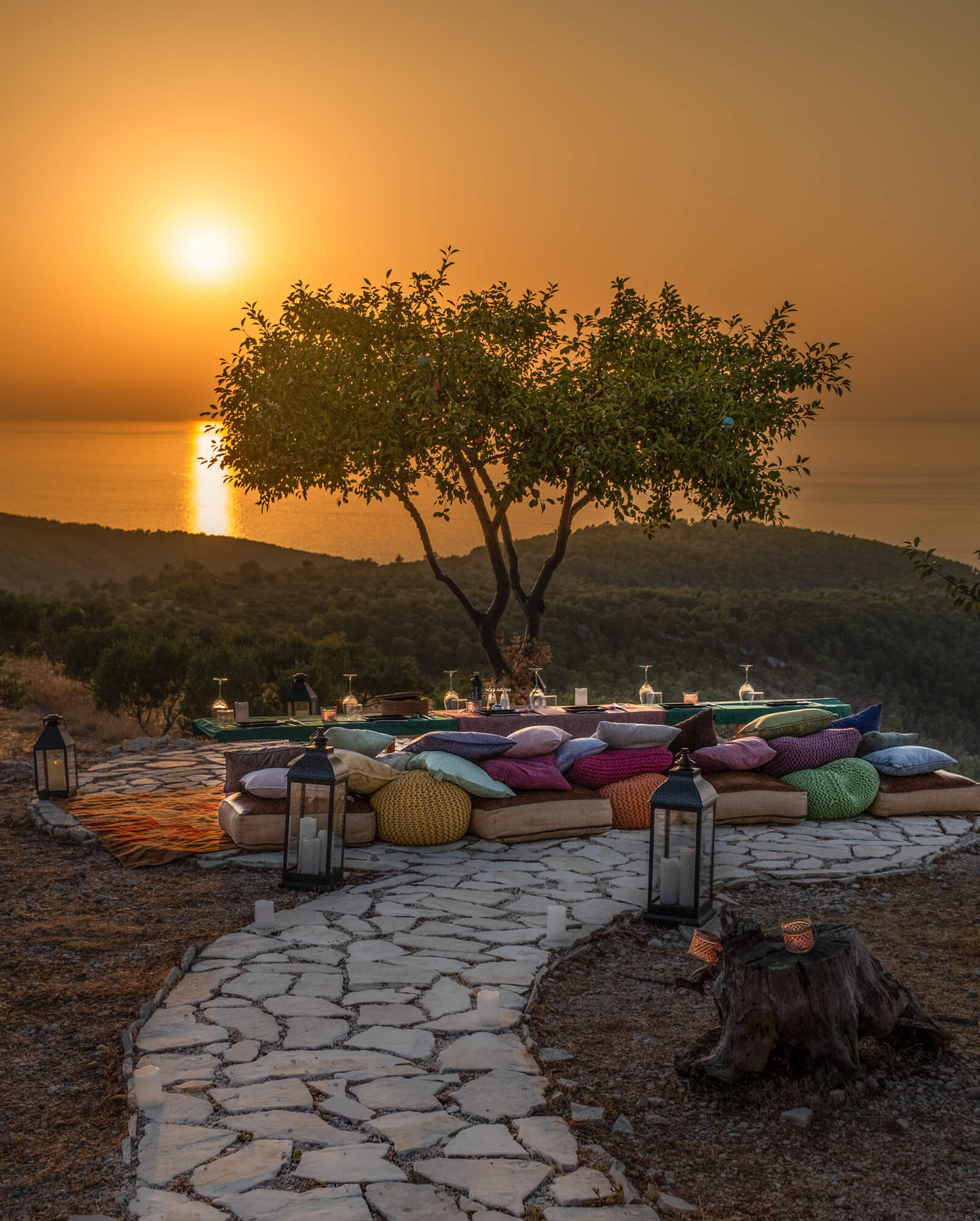
One Table Restaurant, Hvar Island (Photo: Timotej Gošev)
Regarding the promotion of tourism in Croatia, what aspects and efforts made by the national and local tourist boards in the last two years can you highlight?
I don’t see anything the National Tourist Board does, and as the majority of the tourist sector in Croatia, see them as irrelevant, and a waste of taxpayers’ money. The Local Tourist Boards, on the other hand, are great. I’ve had the chance to work with a lot of them now. It’s hard to keep everyone happy, but they are doing their best. I can say and see they are finally embracing social media, and valuing its importance more than ever. Making sure they have a strong social media presence, as well as using people like me, and other Croatian photographers to showcase their tourist regions to the world.
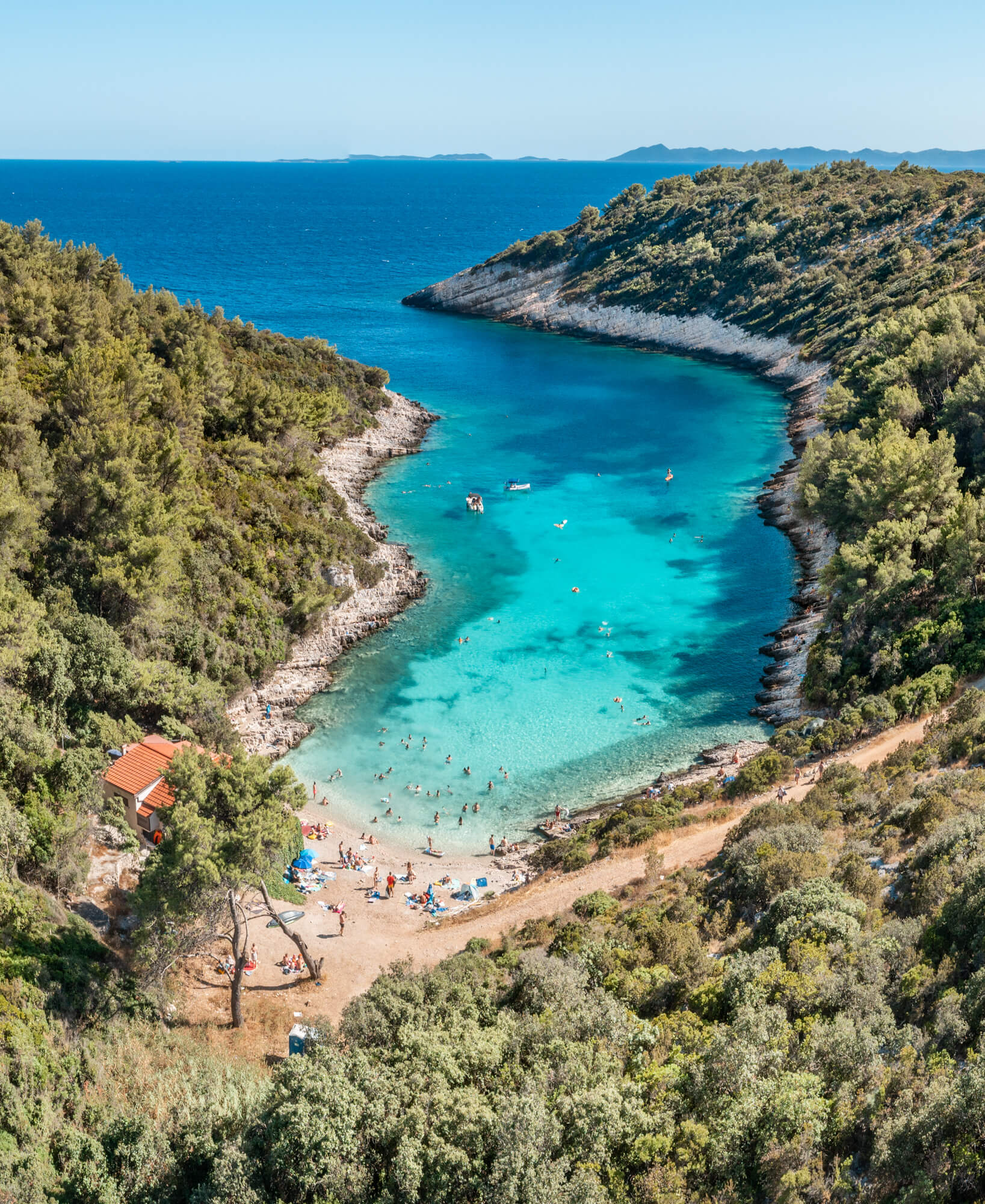
Žitna Beach, Korčula Island (Photo: Timotej Gošev)
In what aspects do you think the promotion of tourism in Croatia should improve? Is there something you can criticize?
The biggest issue I noticed is the relationship between the local tourist boards, and the locals working in the tourist sector. It seems everyone is against the tourist boards and everything they do, with only a small minority pleased. I’ve been to places, and I like to talk to locals, and the moment they find out I’m involved with the local tourist board, they don’t want anything to do with me! Why? Well for starters Local Tourist boards should have nothing to do with political elections and political parties. The tourist boards should exist to serve the tourist, those offering tourist services, and they should be neutral. Also too many tourist board employees, naturally have friends working in the tourist sector and thus drive tourists to only use their services. I think you can guess what kind of issues that can create. The tourist boards should be the pride of the local tourism sector. A fair helping hand, letting the tourists know all their possibilities. Show them all the options on offer, and let them choose which to go with. I also really think it’s time for an official tourist app, where everyone in the tourist sector can list their tourist offers for free. Create it with taxpayer money. Tourists can use the app to find out and search for everything. Beach information. Boat rentals. Taxi numbers. Available accommodation. In 2021, one shouldn’t have to go to a tourist office for information anymore.
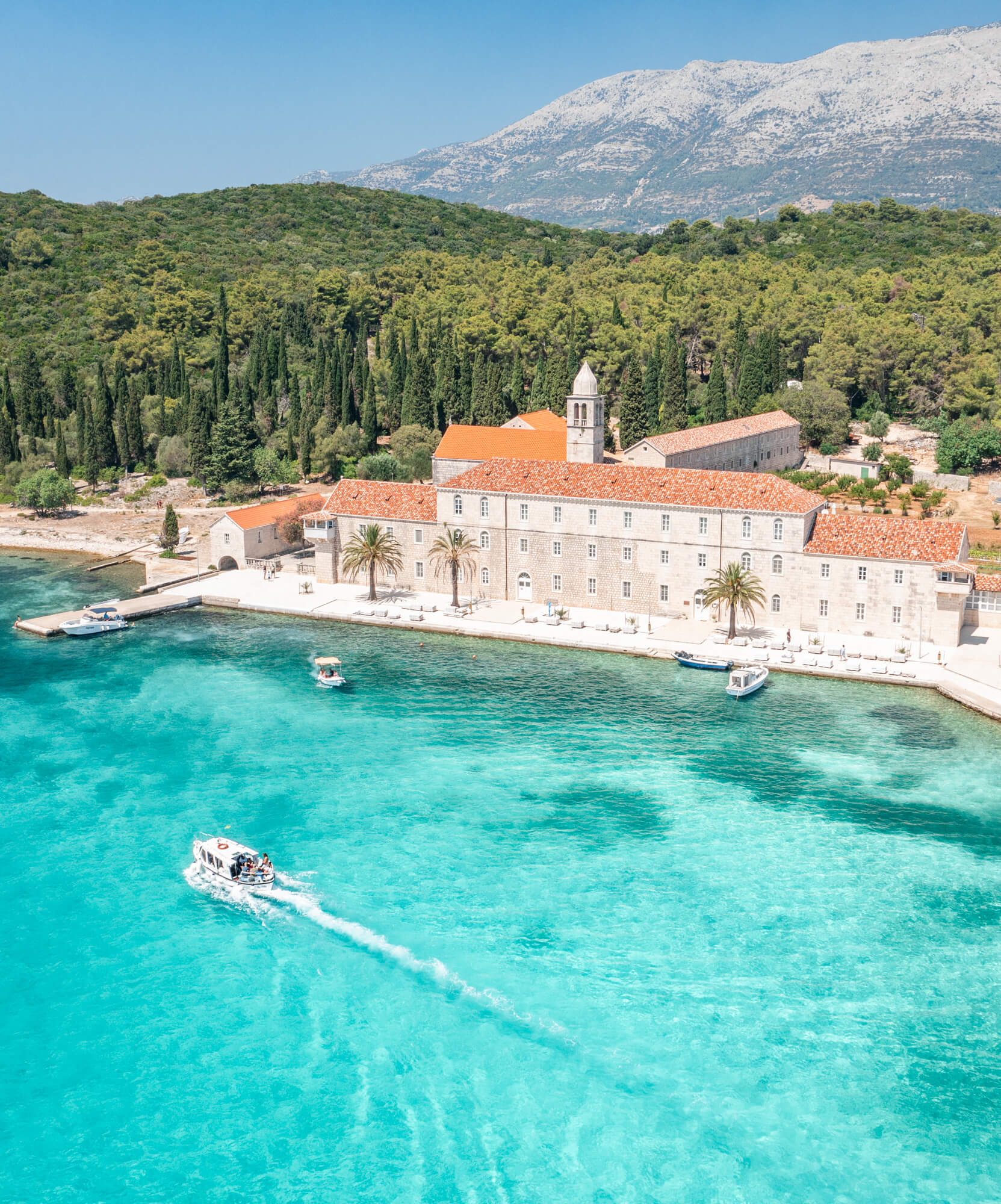
Badija Island (Photo: Timotej Gošev)
In what ways can photographic content contribute to effective tourism promotion in Croatia? How important is it?
People travel to different places in the world for different reasons. Everyone is looking for something specific. An image they have seen either in a photo or video usually serves as the primary mental motivation for doing so. They want to see that image with their own eyes. I have always argued that people come to Croatia first and foremost for the natural beauty of the sea and beaches. The old towns. Natural parks. I loved our old tourist slogan, the Mediterranean as it once was. So, before booking a flight or hotel, people want to know what the particular area they are potentially going to visit has on offer. I have been the first Croatian photographer to share certain places in Croatia on Instagram for the very first time, and the response was, we had no idea this place existed.
I’ll give you a personal example. I grew up spending summers around Zadar. Since I was a kid. Only recently as an adult, I discovered one of the most beautiful spots in Croatia. Vrsi, right by Zadar. I never saw this spot advertised anywhere. So I never went there. Some beaches like Zlatni Rat were advertised everywhere, so normally, I went there, and it was crazy crowded. By showing a little bit of every place, you are now giving people the choice to go to so many places.
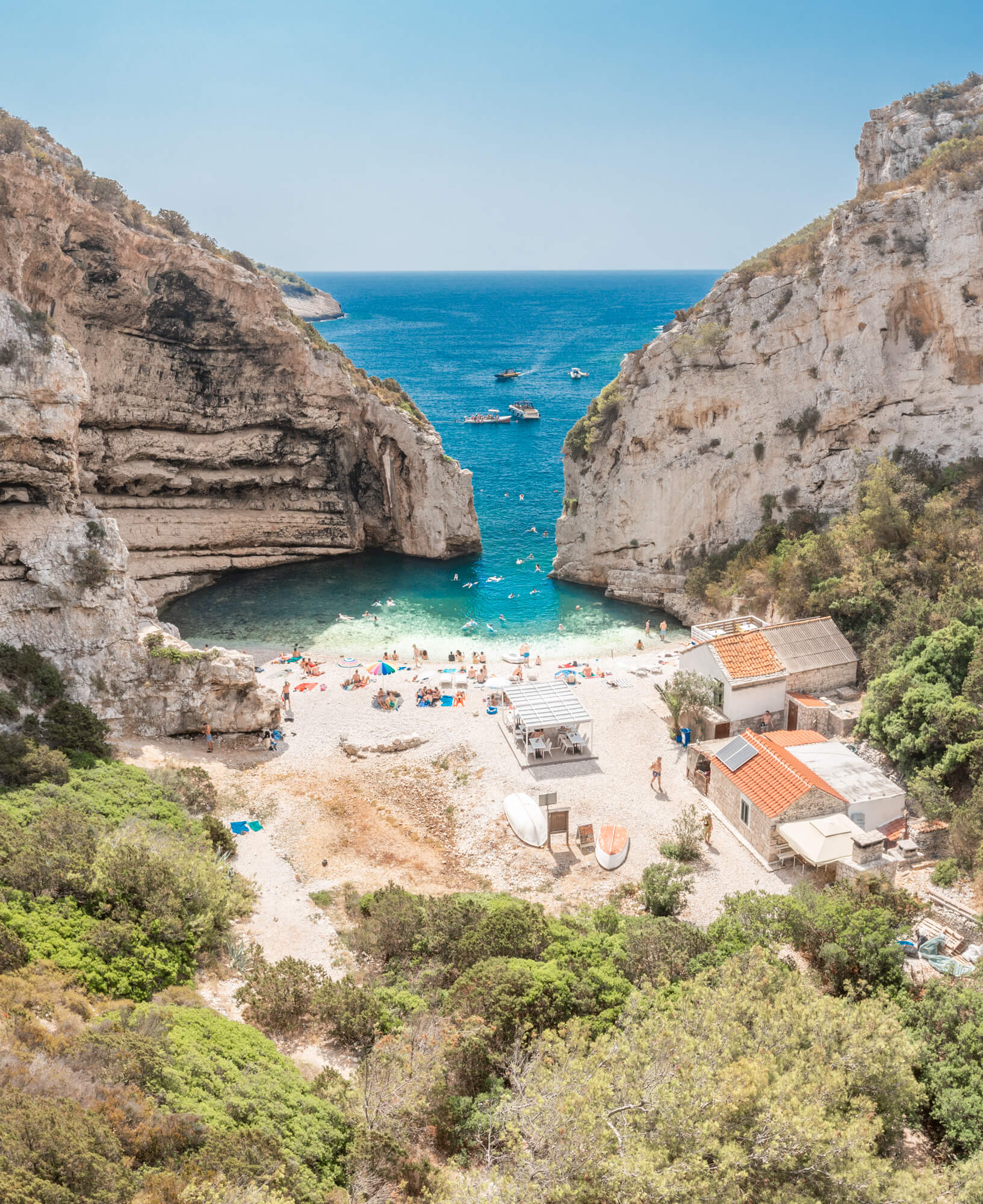
Stiniva Cove, Vis Island (Photo: Timotej Gošev)
If you could describe Croatia to your followers as an ideal travel destination, based on five unique aspects, which ones would you choose?
1. Raw natural beauty everywhere. 2. The crystal clear blue water. 3. Safety. We are an extremely safe country for tourists throughout the day and night. One of the lowest crime rates in the world I believe. 4. Quality of food and drink. 5. There’s something for everyone.
Is there anything in particular in Croatia that catches your attention and would you like to investigate further? I have seen that at some point you inquired about the history of abandoned stone houses on the Croatian coast and islands. It is really a fascinating subject.
The abandoned stone houses are a sad story. I really hope the property ownership laws change soon. They are killing Croatia. A lot of people say it’s impossible. But I believe there’s an easy fix to it if you apply common sense. Pass a law, that every property in Croatia within 2-3 years has to have one owner owning 100% of it. No more multiple owners, owning small percentages. If some owners can’t agree on a deal between themselves, it goes to auction among all the owners, and the highest bidder gets the property. Why hasn’t this happened? I hear lawyers in Zagreb make a killing on these property disputes. I also think Croatia has a serious waste management problem. Especially on the islands. I’ve heard shocking accounts from those who live on the islands about what really happens with the waste tourism generates. I think the situation is worse than many believe. And if that’s really true, we need to do something about it. I truly believe the world sees Croatia as a clean country where natural beauty can be seen in abundance which is its biggest selling point. The land is really ‘Lijepa Naša’ and it needs to stay that way.
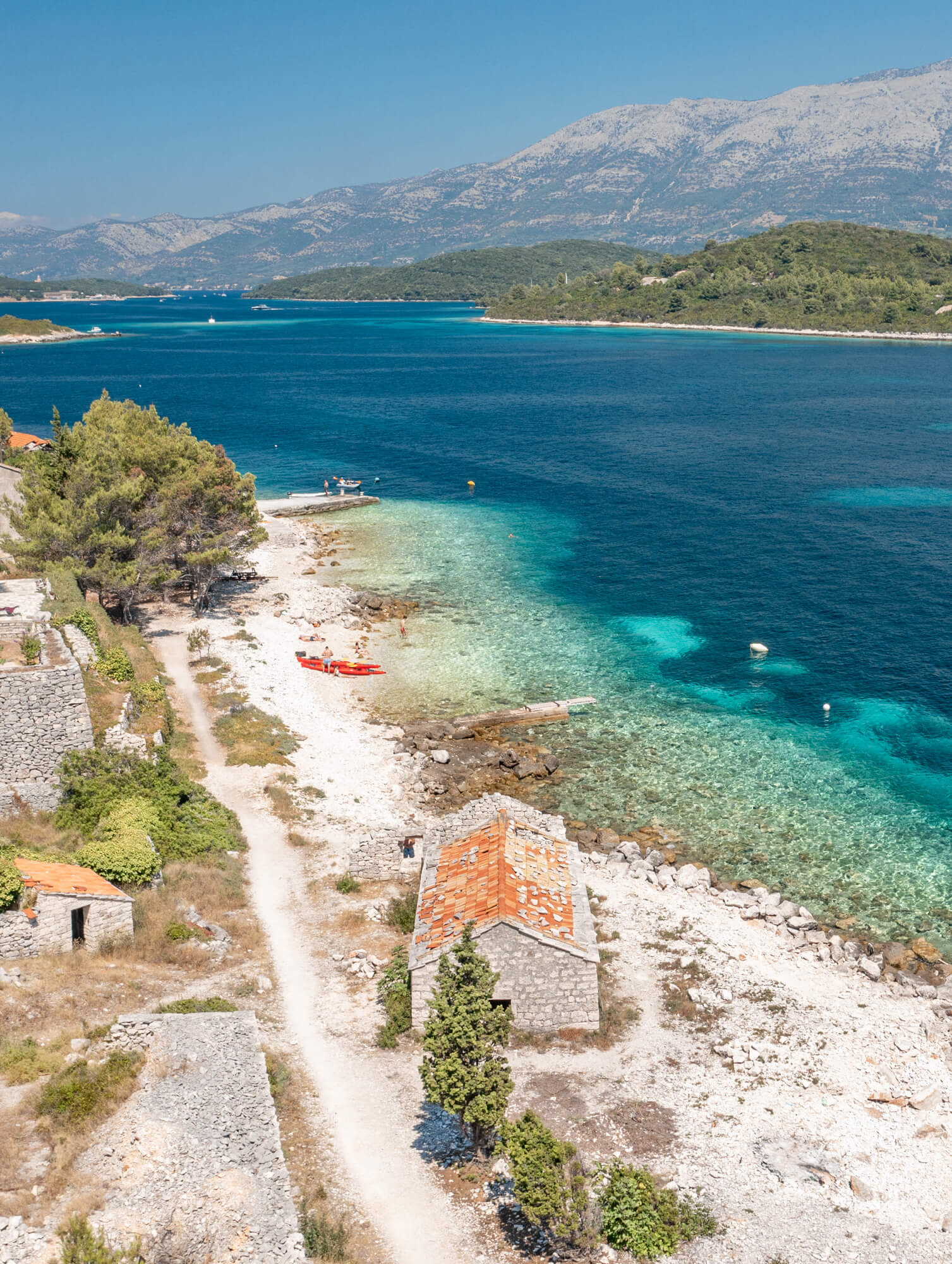
Otok Vrnik (Photo: Timotej Gošev)
Connected with this issue are the party sailing trips such as The Yacht Week. Everywhere they go, they leave so much rubbish behind it's unreal. In the sea. I’ve seen it. Again and again. All the locals I meet in the entire tourism sector as well as those simply living in the spots The Yacht Week comes by, wants these party sailing holidays banned. It’s beyond me how this hasn’t happened yet. Whoever is giving them the green light to continue summer after summer needs to be put in the spotlight.
Besides being a travel photographer, do you also consider yourself a travel journalist? Many content creators upload their photos or videos and that's it, but you like to include reflections, chronicles, and recommendations alongside your images. Is it something that you are interested in developing further in the future?
I grew up reading travel magazines like Conde Nast, and I currently collect travel-themed coffee table books full of pictures with text. There’s always a story behind what you see in a photograph and something to learn. I do consider myself an excellent writer in the English language. People have noticed this, and this past year, a few travel magazines and a national airline, asked me to write for them about Croatia, as well as showcase my photography to their readers. I hope more people will ask in the near future. It’s something I love doing.

Čikat Bay, Lošinj Island (Photo: Timotej Gošev)
What does your Instagram profile look like on a summer day in Croatia? How do you usually interact with your followers or people who need help or recommendations?
During the summer the plan is to share 2-3 posts a day. The pictures being posted are usually what I photographed 1-2 days prior. Also, because we are in the summer season, many of my followers are currently in Croatia, or about to visit. This results in a crazy amount of questions. I used to answer every question without fail in previous years, but with an increasing number of followers, it’s impossible sadly. Remember I’m not getting paid to do this. It takes a lot of time. This summer I was receiving roughly 300-500 messages a day. A lot of people also don’t read the caption in my posts and then send messages, for example, asking what’s the name of the beach in the picture I just posted, without making an effort to read the caption where this has already been stated. This is very frustrating. However the questions generally are usually based on recent posts, so I try to answer a lot of them in one of the next posts or stories.

Bol, Brač Island (Photo: Timotej Gošev)
Besides photography, what other things do you spend your time on? Do you have any other interests or hobbies that are just as exciting?
Out of the summer season, I live in England, so when I’m not working, I really love to play sports. I play football, basketball, volleyball every week, competitively. Then there’s gym and lap swimming. I’ve always been into cooking too. So, always trying to master certain dishes and learn new ones. In the summertime, besides photography, it’s very much every activity connected to the water. I’m a big water sports lover. I love diving. I’m a very active individual. I love the company of friends too. I’m a very social extrovert that likes to laugh a lot.
What next projects do you have planned? What are the next steps in Timotej's life and career?
Oh, I have a lot of ideas. Some are already slowly turning into reality. I would love to see more art stores around the world selling my prints of beautiful beachscapes from around Croatia. At the moment it’s just a few in England. As well as being a good photographer, I also believe in my ability to capture video, so expect to see some epic short films soon. I’m also already working on my very own coffee table book taking you on a journey around Croatia’s coast and islands. I’m really excited for this. I have the photographs and text, and just need to find the right publisher to make the dream come true. Lastly, due to demand, I think I will slowly get into trip planning. So many people want me to plan their visit to Croatia. I’m honoured.

Pritišćina beach, Vis Island (Photo: Timotej Gošev)
Your talent as a photographer, and your Instagram account, have resulted in many collaborations over the last few years. What’s your favourite one so far? Is there one you would really love to do in the future?
It’s hard to pick a favourite. I love them all. This past summer I did a collaboration with Valamar Hotels. Had the chance to visit all their hotels across Croatia over a period of 6 weeks. It was amazing. Shooting the hotels, rooms, beaches in front of the hotels. The facilities. Loved every second. The sailing collaborations are always unforgettable too. What would I love to do? Shoot Villa Sheherezade in Dubrovnik. Or shoot a mega-yacht in Croatia. I dream big.
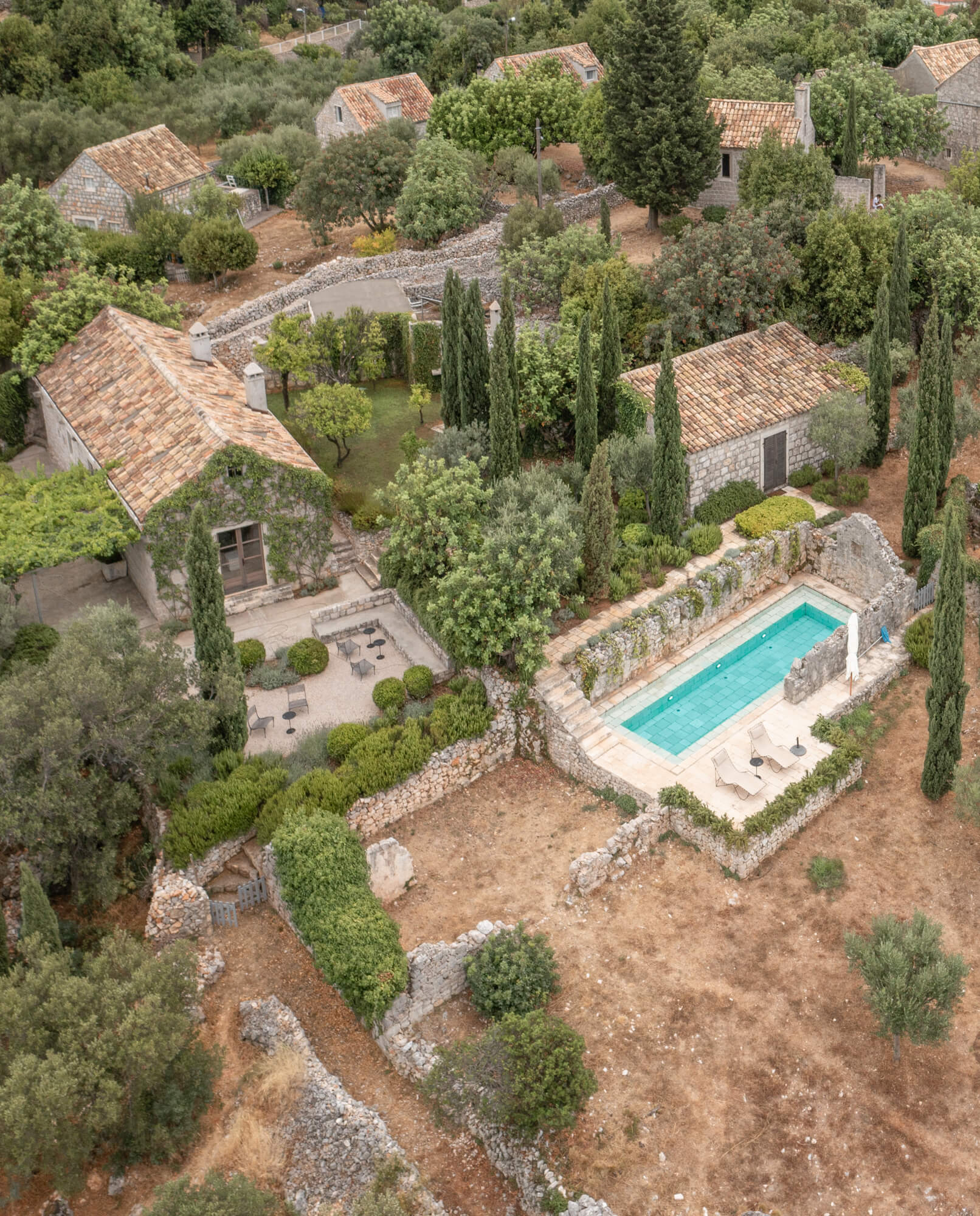
Lopud Island (Photo: Timotej Gošev)
Finally, are you planning to ever move to Croatia permanently?
If you ask me, “Timotej, would you like to live in Croatia one day?” The answer is obviously going to be a definite yes, yes I would. However, I wouldn’t want to live there throughout the whole year. I can see myself living there between April and October. I’m the type of person who dreams of having multiple homes. At least two in two different countries. But in life, you should also never say never. If the right opportunity arises, who knows, I might end up living in Croatia all year long. Living there would give me the chance to photograph Croatia during all the seasons, and not just summer.
For everything you need to know before planning your next summer vacation in Croatia and all these magical destinations shown in this article, be sure to check Timotej's Instagram account and our new guide to everything Croatia, Total Croatia, here.
If you don't have Instagram, follow him on Facebook.
For more on lifestyle, follow TCN's dedicated page.
For more about Croatia, CLICK HERE.
Lopud: Carless, Timeless, Carefree Dalmatian Sunset Heaven
September 2, 2020 - Continuing a look at the recent TCN trip to the Elaphiti islands off Dubrovnik, meet magical Lopud.
Although I am fairly well travelled around Croatia, there are certain gaps in my knowledge and experience, one of the most gaping of which has been the fabled Elaphiti islands of Kolocep, Sipan and Lopud. That changed this summer in what was for me the discovery of 2020 so far, as well as a new perspective of Dubrovnik as a tourist destination.
My first enchanting introduction was the nearest island to Dubrovnik - Kolocep (known locally as Kalamota), just 30 minutes by regular daily ferry from the Pearl of the Adriatic (you can read more in Arise Kalamota! Kolocep, 30 Mins from Dubrovnik But a World Away).
Next along the Jadrolinija route was Lopud, another island free of cars, and one which my friend Kresimir Macan has been championing for years, as he spends a month there every August. When he showed me the bedroom view from one of the apartments he stays in, I could quite understand why. Not a lot wrong with waking up to that each morning...
Every island is different in Croatia, and if I was seduced by Kalamota, I was blown away by Lopud. It seemed to be an island with so much simplicity and yet so much depth, history, tradition and culture. And the more I looked into things, the more unusual things I found.

(Photo credit Wikipedia)
Lopud is essentially two parts. A hike through the trees to the other side from the ferry will reward you with one of the best sandy beaches in all Croatia at Sunj. If you are looking to truly get away from it on a beach day, it doesn't get much better than this on a carless island.

(Photo credit Taliah Bradbury)
But the main action happens on the other side of the island, one gorgeous stone drag of Dalmatian life with not a car in sight. It is a hive of activity, with fish deliveries an improvisation. A good lunch for someone.
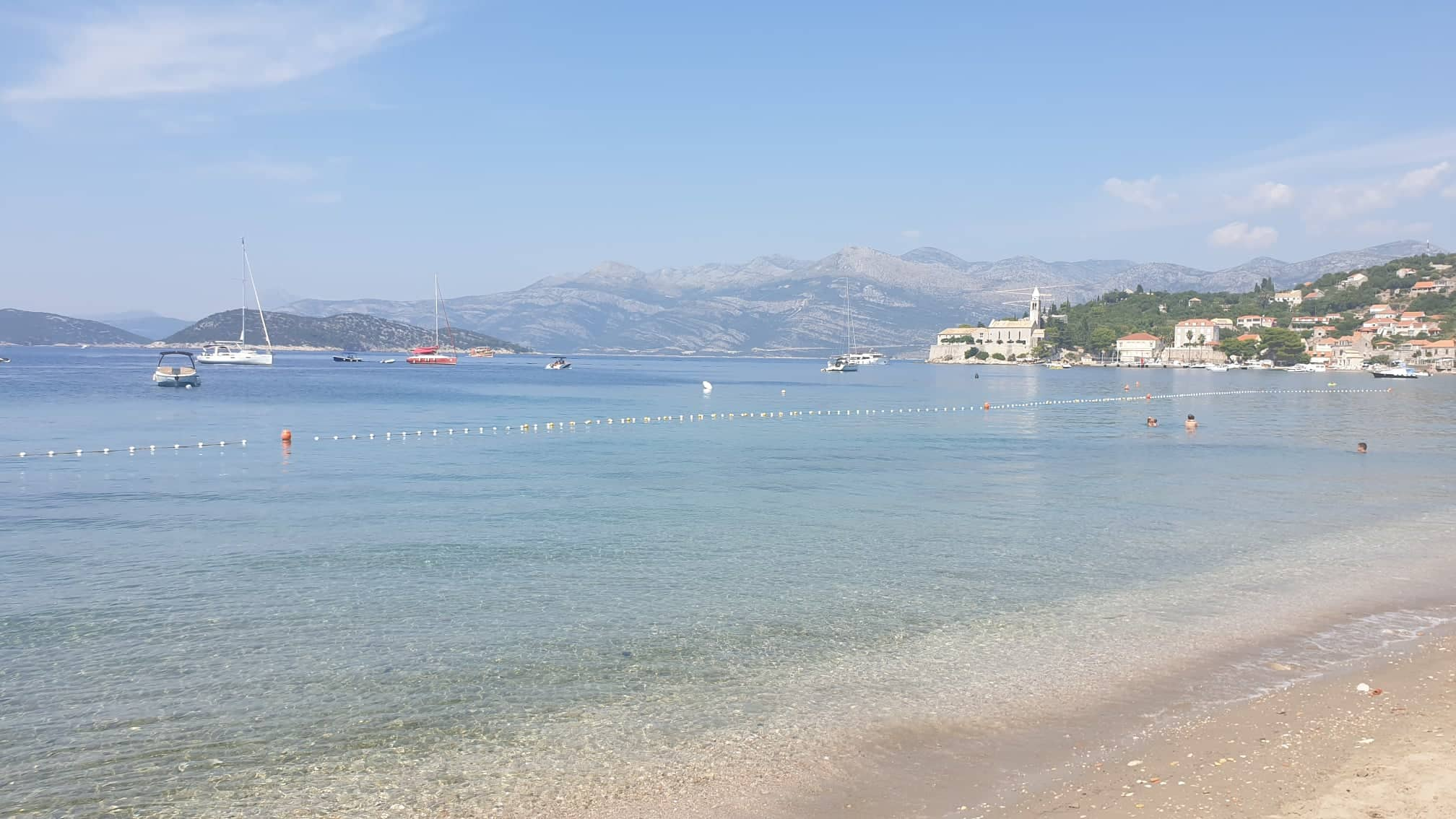
And beaches right in the centre of town, very family-friendly. The Lopud riva for me was a really interesting place. It had the feel of a lively Dalmatian town, while at the same time appearing a complete chill zone for tourists and locals alike. So many different types of people mixed into one, and intermingling. The locals of course, as well as those born here who return religiously each year (I met several of these, including a restaurateur in New York), plenty of people from Zagreb reconnecting with each other under relaxed and azure Dalmatian skies. And tourists of course who interacted freely with their friendly local hosts.
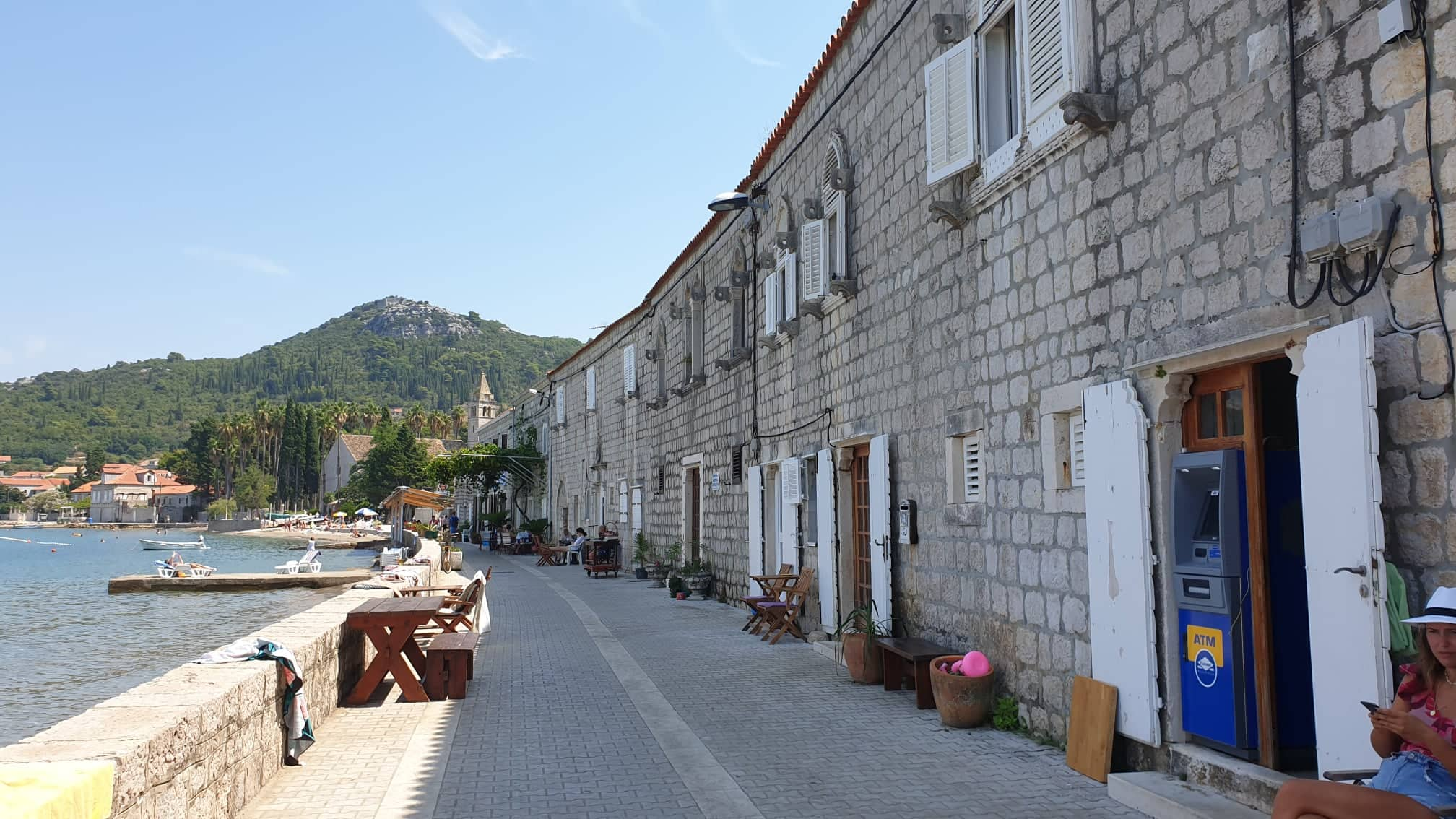
The riva was also the living room for those living and renting on the waterfront. Dining tables and each chairs put out in front of the houses. It added to the feeling of welcome and intimacy. this was a very friendly island.

And one of great seafood, the freshest catch of the day.

Lopud also has some rather unusual claims to fame, including apparently the tallest palm trees in all Europe, as well as Europe's first ever concrete hotel, built in 1936, which is scheduled for renovation soon. You can learn more on both in Secrets of Lopud: Europe's Tallest Palm Trees Shade Europe's Oldest Concrete Hotel.

And next to the palm trees and the concrete hotel, just one of 30 impressive churches and two monasteries on Lopud which tell part of the tale of the island's former wealth and glory days.

(Photo Lopud-1483)
Glory days which are coming slowly back, perhaps, with one of those monasteries opening this summer as one of the top luxury 5-star hotels on the Adriatic. Check out the fabulous LOPUD-1483 converted island monastery.
For Lopud has quite a history, with human habitation dating back at least to the 7th century. Refugees fleeing from the Ottomans in the 15th century increased the population considerably until the 17th century when an incredible 14,000 people lived on the island. That compares to just 249 in the 2011 census.
Lopud was at the heart of the dominance of the Dubrovnik Republic's seafaring success, and at its height, the island was home to about a quarter of the republic's navy, with some of its most famous sailors being Lopud men.
At its height of the seafaring prominence of the Dubrovnik Republic, it was a place of immense culture, but disaster struck in 1667, with a devastating earthquake which badly damaged both Dubrovnik and Lopud, but while the Pearl of the Adriatic recovered, Lopud did not. The result for tourists today is a charming and lush island full of wondrous vegetation and historic buildings.

(Romulic and Stojcic)
Lopud's most famous son is undoubtedly Miho Pracat, the wealthy 16th-century merchant, who won made and lost (through shipwrecks) fortunes, and whose bust today can be found in the Rector's Palace in Dubrovnik.
According to legend, having lost his fortune for the second time when he lost his fleet, Pracat decided to return to Lopud and live out his days in a modest manner. While sat alone feeling sorry for himself, he noticed a lizard trying to climb a wall. The lizard failed twice, falling both times. But on the third attempt, the lizard succeeded, prompting Pracat to swear an oath that he too would try again. As with the lizard, it was a question of third time lucky, and he went on to become not only immensely rich, but also a great benefactor and meritorious citizen of Dubrovnik.
Perhaps his most famous hour was a conversation with a grateful Charles V after his ships circumvented a blockade and delivered grain to the king's troops. The king summoned the merchant during his morning shave to ask him what he wanted to show the king's gratitude, to which the Dubrovnik merchant replied that he had no need for anything as he was wealthy enough, but he would take the king's shaving serviette.
The serviette is on display in the Museum of Lopud to this day.

Enough of the history, as the sun is setting at the end of another perfect day. Time to enjoy one of the true highlights of this magical island - sunsets.
Kreso's Facebook feed in August is always dominated by Lopud sunsets, which are truly some of the most spectacular on the coast. The ideal day to chill after another relaxing day in carless, timeless Dalmatian heaven before taking in the night view.

For the latest travel info, bookmark our main travel info article, which is updated daily.
Read the Croatian Travel Update in your language - now available in 24 languages
Secrets of Lopud: Europe's Tallest Palm Trees Shade Europe's Oldest Concrete Hotel
August 15, 2020 - Continuing our look at the secrets of the Elaphiti Islands near Dubrovnik, a visit to Lopud, home to Europe's tallest palm trees and oldest concrete hotel... with quite a history.
Depending on who you speak to, Croatia has between 1185 and 1246 islands in its pristine Adriatic Sea, but one thing is for sure after 18 years of living here - no two islands are the same, and each has its own speciality and uniqueness. Nowhere was this more evident to me than on my first visit to the islands of Kolocep, Lopud and Sipan near Dubrovnik, the so-called Elaphiti Islands.
Just half an hour by regular ferry from Dubrovnik, these enchanting islands are a world so far away from Dubrovnik that they offer the perfect holiday in Dalmatia - total relaxation on islands without cars (Sipan excepted), and yet a short boat ride away from the hustle and bustle of the UNESCO World Heritage Site that is Dubrovnik. All played a major part in the impressive history of Ragusa, the Dubrovnik Republic, an era where Dubrovnik shipbuilding and trading was globally famous, and whose riches filtered down into opulent stone villas in the city and on the islands.

The Lopud waterfront is magical. It has the feel of a civilised Dalmatian fishing town, a place of culture and heritage and yet one of relaxation and informality. Each of its waterfront buildings has several centuries of stories contained therein, but one building truly stood out as we wandered along. For this was a building not of stone, but of concrete, whose gardens were shaded by what is to claimed to be the tallest palm trees in all Europe.
They are certainly tall!
The Grand Hotel, which looked like this in better times, also had a European claim to fame to match the palm trees - it is the oldest concrete hotel in Europe. A curious thing to find on a Dalmatian island, perhaps, but Dalmatian islands are also home to the oldest public theatre in Europe and the birthplace of cricket in Europe outside the UK (wondering what else you don't know about Croatian islands - here are 25 things to know).

One of the things that I have learned with age in Croatia is that there is always a much better story about a building or attraction when told by a local than told by a guidebook. And so it proved on Lopud. I was introduced to a very handsome man in his late 50s or early 60s, as the man who knew the concrete hotel better than anyone alive. I will call him Mario.
For Mario was a legendary'galeb', the famous Dalmatian Casanovas who would prey on attractive young female tourists and give them an unforgettable summer experience.
For, it appeared, the Hotel Grand was the biggest galeb playground of all.

But let's start at the beginning, back in 1936, when the hotel was opened by its Czech owners after the bold architecture of Nikola Dobrovic, whose reenforced concrete hotel was his crowning work - and also the first concrete hotel in Europe. According to Mario, it was in the shape of a ship from above, complete with a tennis court on the roof, and it looked out to the Adriatic through those impressively tall palm trees, as well as ubiquitous bitter orange trees, for which Dubrovnik is famous.
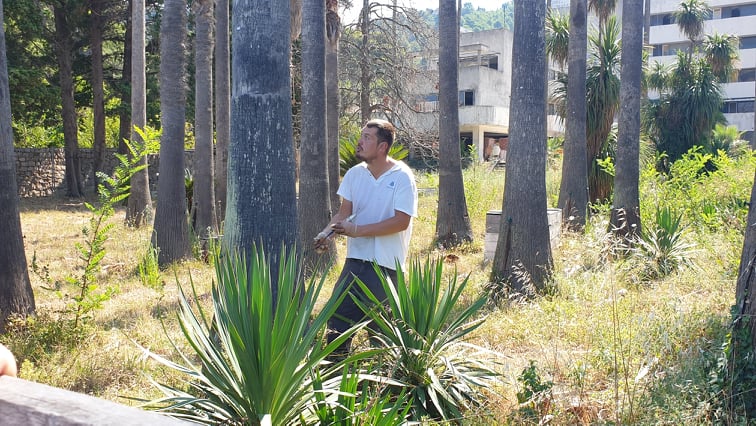
Palm trees which continue to be protected today, as we noticed on our visit, as one worker injected the required chemicals into each tree to enhance their wellbeing.
When the Grand Hotel opened in 1936, it was quite a statement for tourism in the region, and the elite society from Prague flocked to Dalmatia to see what all the fuss was about. Those who were particularly well off even arrived by hydroplane.
Then came the Second World War, an end to tourism temporarily and a new use for the young concrete hotel - an internment camp for the Jews of the Dubrovnik region. Some 600-700 were interned there.
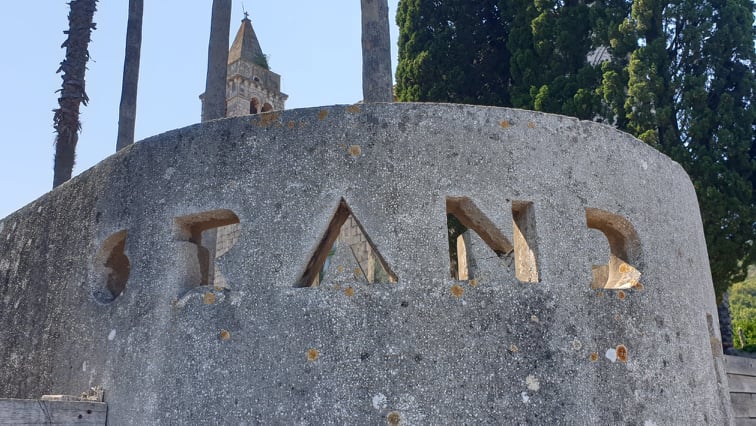
The glory days of this unique concrete hotel were undoubtedly the 1980s before the Homeland War. Life in former Yugoslavia was cheap, life was very liberal, and tourists came to visit knowing they would have a wonderful sun-soaked relaxing vacation at an affordable price.
And there was entertainment. Mario took us on a tour of his old haunting grounds, marvelling at the palm trees today as he had back then. There used to be so many bitter orange trees before, he explained, and the band was here. This was the nightlife of the island, and this is where the action happened. His fellow galebs were competition for the best girls on the night, great friends swapping stories over a morning swim the following day.

It was a carefree existence brought to an end in 1991 for the same reason as things stopped in 1939 - war.
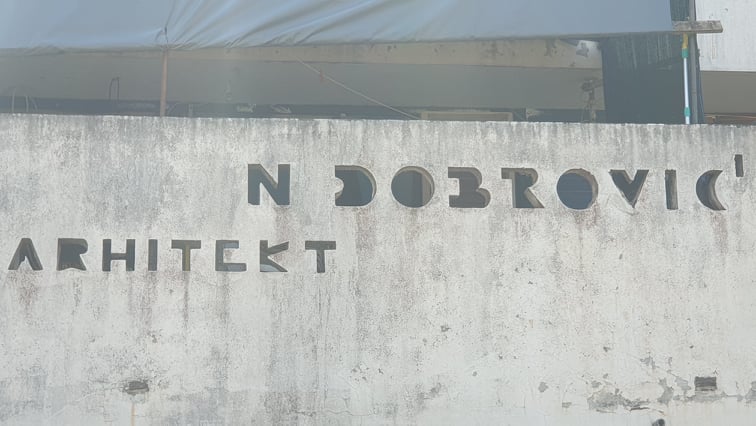
The hotel, whose entrance has its architect's name carved in concrete, fell into disrepair, a shadow of its illustrious past.

Things might be changing finally, however. Italian investors bought the main hotel on the island, as well as the concrete Grand. Hotel Lafodia is the main accommodation option on Lopud, at the end of the bay, and nearby a concrete villa also designed by Dubrovic.
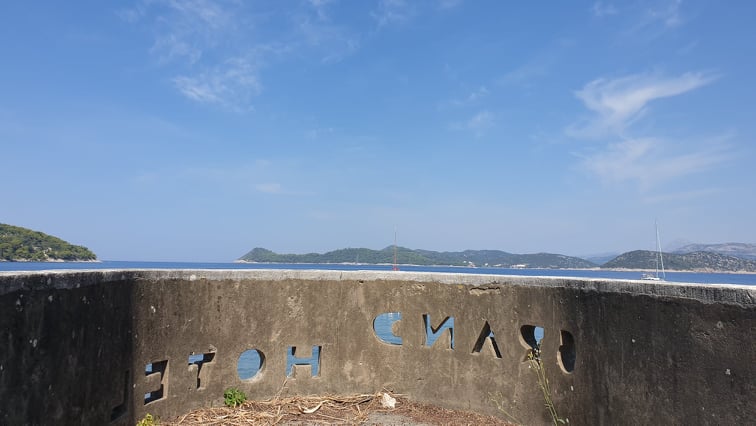
Plans are in place to renovate the famous concrete hotel, reducing the number of original rooms to provide more spacious accommodation for modern needs.
And while we wait, those tall palm trees will continue to sway gentle in the evening breeze, as they observe yet one more of some of the best sunsets in Europe.
Lopud is divine.

For more about travel in Croatia, visit the dedicated TCN section.
Gospe od Špilice: Lopud Monastery Opening as Luxury Hotel
This Lopud monastery was established way back in the year 1483, from which the hotel draws the name Lopud 1483. The hotel is something between a museum, an elegant boutique hotel and a spiritual refuge of the 21st century, along with a church, a bell tower and a stunning Romanesque cloister. There is also a ''sacred garden'' inspired by the Dubrovnik gardens inside the Lopud monastery itself, with various types of lavender, citrus and fruit trees and much more.
At the very entrance to the monastery there is an elegant dining room modelled on the one in Francesca's own family home in Lugano. Next to that room is a residence with impressive artwork. The hotel has five spacious, elegant bedrooms that were once Franciscan cells. All of the furniture was made by the Italian minimalist Paola Lenti, and each room is decorated with a piece of historical furniture.
The hotel will not have a restaurant as such, but it will have a chef. There is no pool either, but there is a staircase leading straight to the sparkling Adriatic sea where you can swim. Guests will have SUP boards, kayaks and fishing equipment as well as a personal trainer and yoga teacher on call all at their disposal when staying at the Lopud monastery
On top of all of that, a shaman from northern Sweden has created a map with nine places in which to meditate in the gardens which are full of herbs that alleviate anxiety. Lopud 1483 offers an exclusive stay for 10 people from 8 thousand euros per night or double rooms from 1400 euros per night from September onward.
With its five rooms, the Lopud 1483 hotel will open on the principle of an exclusive stay in July and August, while in the first days of September it will once again become a ''conventional'' hotel.
For more, follow our travel page.
Construction of Sewage System on Island of Lopud Underway
As Morski writes on the 26th of January, 2020, two underground sewage pumping stations, five kilometres of new pipelines and a submarine outfall, as well as a wastewater treatment plant will soon be constructed on the island of Lopud, just northwest of Dubrovnik.
A contract for the construction of the sewage system, worth 12 million kuna in total, was signed today between a representative of the Dubrovnik water supply company as the investor, and the Zagreb-based company Energoherc as the contractor. The signing of the contract was also attended by the Mayor of Dubrovnik, Mato Frankovic (HDZ).
Dubrovnik Mayor Mato Frankovic said he was pleased to sign the third contract for the construction of a sewage network in the area of the City of Dubrovnik, on this occasion the island of Lopud, in such a short time.
''What's a particular pleasure is the fact that we're starting with the first Elaphite island, on which one of the most important problems is the lack of a sewage network. The fact is that our tourism rests on the clean sea, and this cannot be the backbone [of Croatian tourism] if there's no sewerage network in the City of Dubrovnik.
That's why it is extremely important to solve this issue for all of the Elaphite islands, and solve the question of all of the sewage network in the city. The island of Lopud's sewer network is the first operation to start this year,'' said the Mayor before thanking the aforementioned investor for another initiated investment, and Croatian Waters (Hrvatske vode), which provided part of the funds and is following this extremely important project. He asked the residents of the island of Lopud for their patience while performing the works.
''The island of Lopud is a tourist destination, but the fact is that during the season a small part of the work can still be performed without being a burden on the season itself. Without the patience and understanding of the residents, it's difficult to get the works done on time and with quality. But I believe we can all be happy because Lopud will get a quality sewer network. They will no longer be burdened by these problems that have plagued them on a daily basis,'' said Mayor Frankovic.
On behalf of the Dubrovnik water company as investor, the contract was signed by the President of the management board, Luksa Matusic.
''This is an extremely important investment for us. Lopud is the first of the Elaphite islands to receive a sewage system. The other islands are of no less importance to us, but we've resolved all of the property-legal relations and obtained a building permit here,'' said Matusic on this occasion, emphasising that this investment is being embarked on in cooperation with Croatian Waters and will endeavor to finish it as soon as possible.
He also touched on the wastewater problems that the residents of the island of Lopud have been suffering from for the last fifteen years and pointed out that the investor has been assisting as much as it can in the last two seasons, although it doesn't have any infrastructure in its ownership.
''After Lopud, I hope that Sudjuradj will be next, in cooperation with the City of Dubrovnik, which has some of its investments planned there. Kolocep and Sipanska Luka are after Sudjuradj, for which we have a building permit. Nobody is less important to us, but here we have all the prerequisites for investing immediately after signing the contract,'' explained Matusic.
The contractor is, as mentioned previously, Energoherc, whose director Ante Simic points out that Dubrovnik, when it comes to functioning, should be an example to the rest of Croatia, which obliges them as contractors to do the job with high quality and within the given deadlines.
According to the announcement, the first machines to carry out the works on the island of Lopud can be expected as of February the 1st, 2020.
Make sure to follow our dedicated lifestyle page for more.
VIDEO: Mediterranean Jellyfish Filmed Close to Lopud Near Dubrovnik
As Morski writes on the 26th of August, 2019, a Mediterranean jellyfish (Cotylorhiza tuberculata) has appeared in greater numbers in the waters around the Elafiti (Elaphite) islands in southern Dalmatia close to Dubrovnik, but this phenomenon appears to be very common and there is no need to panic about their presence.
The jellyfish is about 30 centimeres in diameter and was filmed by Vlado Odribožić when he was out with a group of tourists, sailing towards the islands of Šipan and Mljet. Although residents say they haven't seen these jellyfish in years, experts say there is no need to worry about them.
Pero Ugarković, editor of the Podvodni.hr portal, who is also an author of numerous marine-related texts, as well as also an associate of the Institute of Oceanography and Fisheries in Split, says that these jellyfish are very easily recognised.
''There is an increase of them, it's seasonal, and it is nothing alarming,'' he pointed out briefly.
''This isn't really uncommon, it's like with any other type of organism. This happens cyclically every few years. Some species in the sea like these jellyfish are now passing through in greater numbers, so people are scared. Their migrations are transient and, other than a little fear in humans, they'll leave no other consequences,'' stated Petar Baranović, a marine biologist, fisherman and Morski columnist, who is well acquainted with the marine world because he is almost always dealing with it.
The Institute of Oceanography and Fisheries has already written about these jellyfish, which by their appearance are also often called the "fried egg jellyfish" They are about thirty centimeters in diameter, most noticeable at about one meter deep. This species usually appears in late summer, often accompanied by fish hiding under their ''hats''. For humans, they're generally harmless, but an irritating but weak reaction can occur in susceptible persons, according to the aforementioned Institute.
The species lives throughout the Mediterranean sea, they're endemic, they feed on plankton, and they're commonly found in the high seas, sometimes appearing in the Croatian Adriatic.
Basically, these are spectacular specimens of good-natured indigenous jellyfish that are simply to be enjoyed if seen.
Watch the video here:
Make sure to follow our dedicated lifestyle page for much more.
Lopud's Lafodia Sea Resort Wows Again, Takes Home Prestigious Award
Lopud's stunning Lafodia Sea Resort wows once again, this time taking home a prestigious award. Little else could be expected of this truly beautiful hotel located on an idyllic southern Dalmatian island, just a short boat ride from the City of Dubrovnik.
Winning the prestigious Best Seaside Hotel for Meetings and Events, Lafodia Sea Resort, with more than 150 rooms, showcased its individuality and wow factor. This award means a lot to Lafodia, because the resort has been chosen among seven other hotels some with five stars and chosen by those from within the profession and by people who are the professional organisers of all kinds of event. This welcome recognition means that lafodia Sea Resort is not only recognised by highly appreciated on the market.
The SEEbtm Awards is an awards ceremony powered by SEEbtm magazine, to the best and most prominent hotels and venues in the meetings industry for the current year, based on the votes of the readers, event organisers, and the jury of SEEbtm magazine. The expert jury was made up of 27 representatives of some of the most prominent international companies and each one of them is in charge of the event's organisation.
These awards were established back in 2016 with the idea of rewarding and therefore stimulating positive changes in this very demanding industry and market. SEEbtm magazine specializes in business travel and the events industry in the Southeastern European region, and is supported by the leading regional portal Kongresniturizam.com, which has now been operating for more than twelve years.

Under the expert organisation of the portal Kongresniturizam and the specialised magazine SEEbtm, on November the 15th, 2018, in Belgrade, Serbia, the meetings industry of the region traditionally gathered for the seventh time at the SEEbtm Party, an event which has continued to profile itself as a strong networking platform of key stakeholders in the meetings industry, as well as those in the expert field of event management.
At the SEEbtm Awards gathering, prestigious recognition was given to some of the best hotels and venues in our region in seventeen categories, based on the votes of those who are buyers in the meetings industry, people from the meetings industry from within the region, the clients of the nominated candidates, and the SEEbtm magazine team itself.

What was especially important was the innovation in the voting of an expert jury, composed of the representatives of some of the most eminent companies and organisations which deal with the organisation of events across the region, and their members voted for the best, according to their experience and their valued opinion.


